Master Index
FAQ Home
Welcome to our Frequently Asked Questions Section!
Click on any of the topics at the left to see a list of questions. You can then click on the question to see the answer. Some answers will direct you to other areas of the website, by opening links in new windows. You can always return to where you left off on the FAQ by closing the new window.
If you're having trouble finding a question, use the search bar at the bottom; it will search our entire site for the keyword(s) you enter.
Like to have everything on one page? You can see a list of all topics and questions at once by clicking on the Master Index link found beneath the list of questions. Or, you can pull up our entire FAQ—questions with answers—by clicking on the Complete FAQ link below that. (The page is extremely long, so please allow some time for everything to load!)
If you've looked through our entire FAQ and still have not found the answer to your question, please contact us using the form below the search bar.
Thanks for visiting our website!
Understanding Ring Size
Ring Size (and in particular aspect ratio) is one of the more complex and yet most useful concepts for a chainmailler to develop. Understanding how ring sizes work for different weaves will give you a knowledge base to come back to again and again when starting a new project, troubleshooting, or developing your own weaves.
Please Note: It is important to understand that not all suppliers measure jump rings in the same way and due to the precise nature of chainmaille, measurements and sizes are not easily interchangeable. The information in this section deals strictly with Blue Buddha jump rings.
What do your ring names mean?
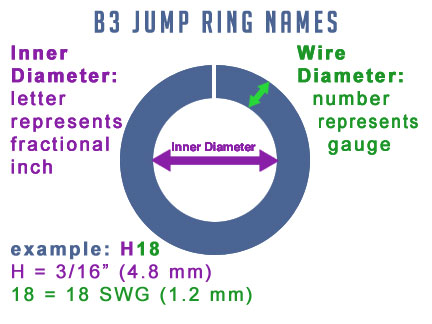 Blue Buddha jump ring sizes consist of a letter (or letters) followed by a number. The letter in our ring name refers to the inner diameter of the ring, and then number refers to the wire gauge. The letters go in alphabetical order with size B being significantly smaller than size X. Wire gauge is a bit counter-intuitive to understand as larger numbers refer to thinner wire (i.e. 20ga wire is much thinner than 14ga.)
Blue Buddha jump ring sizes consist of a letter (or letters) followed by a number. The letter in our ring name refers to the inner diameter of the ring, and then number refers to the wire gauge. The letters go in alphabetical order with size B being significantly smaller than size X. Wire gauge is a bit counter-intuitive to understand as larger numbers refer to thinner wire (i.e. 20ga wire is much thinner than 14ga.)
Inner Diameter = Letter
To understand exactly what the letters mean, please refer to the chart below. Letter A rings are smaller than B, which are smaller than C, and so on. The letters refer to the size of the mandrel that the raw wire was wrapped around. To find the exact inner diameter (ID), after springback, of each rings we sell, look at the base metal stats & uses and the sterling silver stats & uses pages in the supplies section.
We adopted our lettering system from chainmaille artisan Spider (who now uses a different system) because we discovered that many people find it easier to understand that a sequence of increasing inner diameters is F, G, H rather than 5/32, 11/64, 3/16.
If you prefer to refer to our rings in fractional inches or millimeters instead of the letters, it's no problem. Use whatever system you feel most comfortable with. All of our ring pack labeling includes conversions so that you don't have to memorize that F = 5/32" = approx 4.0 mm.
Inner Diameter Conversion Chart
The chart below only goes to size T (3/8"), but you can view a complete Inner Diameter Conversion Chart (PDF) with IDs in 64" increments, from 1/64" to 1" and their metric equivalents. (Having trouble opening the file? Try downloading the latest version of Adobe® Reader®)
| B3 Name | Mandrel Size (Inches) |
also called |
Decimal Inch |
Millimeter Conversion |
 |
1/64 | insanity | 0.016 | 0.4 |
 |
2/64 | 1/32 | 0.031 | 0.8 |
 |
3/64 |  |
0.047 | 1.2 |
| AAA | 4/64 | 1/16 | 0.063 | 1.6 |
| A | 5/64 |  |
0.078 | 2.0 |
| B | 6/64 | 3/32 | 0.094 | 2.4 |
| C | 7/64 |  |
0.109 | 2.8 |
| D | 8/64 | 1/8 | 0.125 | 3.2 |
| E | 9/64 |  |
0.141 | 3.6 |
| F | 10/64 | 5/32 | 0.156 | 4.0 |
| G | 11/64 |  |
0.172 | 4.4 |
| H | 12/64 | 3/16 | 0.188 | 4.8 |
| I | 13/64 |  |
0.203 | 5.2 |
| J | 14/64 | 7/32 | 0.219 | 5.6 |
| K | 15/64 |  |
0.234 | 6.0 |
| L | 16/64 | 1/4 | 0.250 | 6.4 |
| M | 17/64 |  |
0.266 | 6.7 |
| N | 18/64 | 9/32 | 0.281 | 7.1 |
| O | 19/64 |  |
0.297 | 7.5 |
| P | 20/64 | 5/16 | 0.313 | 7.9 |
| Q | 21/64 |  |
0.328 | 8.3 |
| R | 22/64 | 11/32 | 0.344 | 8.7 |
| S | 23/64 |  |
0.359 | 9.1 |
| T | 24/64 | 3/8 | 0.375 | 9.5 |
| U | 25/64 | 0.391 | 9.9 | |
| V | 26/64 | 13/32 | 0.406 | 10.3 |
| W | 27/64 | 0.422 | 10.7 | |
| X | 28/64 | 7/16 | 0.438 | 11.1 |
| Y | 29/64 | 0.453 | 11.5 | |
| Z | 30/64 | 15/32 | 0.469 | 11.9 |
| BB | 31/64 | 0.484 | 12.3 | |
| CC | 32/64 | 1/2 | 0.500 | 12.7 |
Wire Gauge = Number
The gauge refers to how thick the wire is. Different numbering systems are used, depending on the type of metal. Overall, though, as the gauge number decreases, the thickness of the wire increases. (In other words, in the same metal: 24ga is always thinner than 22ga, which in turn, is thinner than 20ga.).
The table below shows the wire diameter of the rings we sell in Sterling Silver vs Base Metal (Aluminum, Brass, Bronze, Copper and Stainless Steel).
Many serious maillers prefer to use wire measurements instead of gauges so that others know exactly what the wire size is. When calculating the Aspect Ratio of your rings, you must convert the wire gauge to either mm or inches to match the units of the rings ID. Your results won't be accurate if you try to plug wire gauges into the AR formula!
Wire Gauge Conversion Chart
| Wire Gauge |
Precious Metal (AWG) |
Base Metal (SWG) |
| 24 |  |
0.02" 0.5 mm |
| 22 |  |
0.025" 0.6 mm |
| 21 | 0.029" 0.724 mm |
 |
| 20 | 0.032" 0.8 mm |
0.032" 0.8 mm |
| 19 | 0.036" 0.912 mm |
 |
| 18 | 0.04" 1.024 mm |
0.048" 1.2 mm |
| 17 | 0.045" 1.15 mm |
 |
| 16 | 0.051" 1.291 mm |
0.062" 1.6 mm |
| 14 | 0.064" 1.63 mm |
0.08" 2.0 mm |
| 13 | -- | -- |
| 12 |
0.081" 2.025 mm |
0.104" 2.64 mm |
| 11 | -- | -- |
| 10 | 0.102" 2.588 mm | 0.128" 3.25 mm |
Buying from other suppliers
When purchasing jump rings elsewhere, it is important to note how they are measured, as every supplier does it differently. Most places measure the inner diameter of the ring, however a few use the outer diameter. Some prefer inches, some are metric and others combine both systems! Adding to the confusion, wire gauges are not consistent. Some suppliers use AWG for all their rings while others use SWG for all their rings. Most, like Blue Buddha, use a combination of the two systems. You should always ask your suppliers for the exact measurements of their rings after springback to ensure you are buying what you need. (If you are not familiar with springback, it is explained in the Common Terms page of the FAQ.)
What size rings should I use for my project?
There is no easy answer to this question, because it depends on what pattern you'd like to create. Chainmaille is such a sensitive craft that half a millimeter can be the difference between a weave working well and being impractically stiff. To decide what rings to use, we suggest you first determine what project you'd like to make (see Choosing a Chainmaille Project). Once you know that, you'll need to figure out the best ring size. This is done by understanding what aspect ratio works for the weave you want to make and then choosing a ring with that aspect ratio. More about what aspect ratio is and how chainmaillers use it in the other answers in this section.
If you're a beginner, we suggest starting off with rings that have an inner diameter of at least size H (3/16", 4.8mm). Any smaller, and you may become frustrated, unless you're used to working with tiny things! You may find the Weave Ideas category of our blog helpful to see what weaves work in some of our most popular sizes.
Note that Choosing a Chainmaille Project also has information about buying the right supplies for your project.
What is aspect ratio?
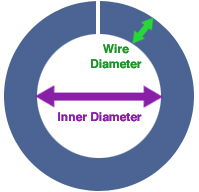
Aspect Ratio is a number that represents the relationship between the wire diameter and the inner diameter of a particular size jump ring. Do not confuse AR with ring size. Very large and very small rings can have the same AR and therefore, work in the same weaves.
Here's an example:
Let's compare the same weave, Möbiused Rosettes, made with rings of varying ARs. We will begin by looking at two ring sizes that are very different but actually have the same AR - our T14 rings (14ga 3/8" / 14ga 9.5 mm) and our F20 rings (20ga 5/32" / 20ga 4.0 mm). The T14 rings are significantly larger than the F20 rings, yet they share a similar AR of about 5.0.
Mobiused Rosettes using T14

Mobiused Rosettes using F20
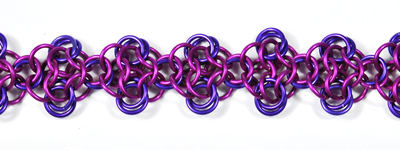
As you can see, the weave works very similarly in each size. While the finished products are different in overall size, the space between the rings and the tightness of the weave is almost the same.
To compare, let's look at the same weave in size T16 (16ga 1/4" / 16ga 6.4 mm) which has a higher AR of about 6.5.
Mobiused Rosettes using T16

As you can see, there is far more negative space in this weave that the others and it feels much looser.
Likewise, we can look at the weave in size F18 (18ga 5/32" / 18ga 4.0 mm) with a lower AR of about 3.7. Notice this size has the same inner diameter as one of our first examples F20, but the thicker wire lowers its AR making weaves tighter. In fact, the weave is so tight that the secondary Mobius rings don't fit in between each rosette, and so this sample is made using the regular Rosettes weave. (The mobiused rings would, however, fit on the edging rings, making the weave even denser than it is.)
Rosettes using F18
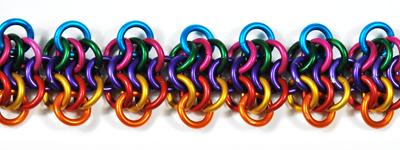
In this example, you can see there is much less negative space between the rings and it appears tighter.
Aspect Ratio can be confusing to understand but as you can see, it has a substantial affect on your finished weave. The images above were taken from the posts in the Weave Ideas category of our blog. You may find this a helpful resource in finding and comparing weaves that work with different ARs.
In the coming months, look for a video that demonstrates AR in action and should help to illustrate just what AR is and how it is used by chainmaillers.
How do you calculate aspect ratio?

The exact formula to calculate aspect ratio is inner diameter divided by wire diameter, or in shorthand:
AR = ID ÷ WD
Before using the formula, make sure to convert the wire gauge to millimeters or inches (to match the unit system used for the ring's ID). Our Jump Ring Sizes page contains a chart with inch and millimeter measurements for the wire gauges we sell. Note: Different metals use different gauge systems.
 For accurate results, use calipers to measure the ID of your rings rather than relying on the mandrel size. Two rings from different suppliers wound around the same mandrel usually yield different IDs, because each supplier uses different tension. Rings of different gauges wound around the same mandrel also yield different IDs, because springback for the gauges is different. (For more about springback, see Common Terms.) Aspect Ratios for chainmaille jump rings generally range between 2.9 and 7.0.
For accurate results, use calipers to measure the ID of your rings rather than relying on the mandrel size. Two rings from different suppliers wound around the same mandrel usually yield different IDs, because each supplier uses different tension. Rings of different gauges wound around the same mandrel also yield different IDs, because springback for the gauges is different. (For more about springback, see Common Terms.) Aspect Ratios for chainmaille jump rings generally range between 2.9 and 7.0.
How do you use aspect ratio?
 The aspect ratio of any given jump ring tells you what weaves are possible with that particular ring size. Understanding AR can mean the difference between a smooth, successful project and a LOT of frustration.
The aspect ratio of any given jump ring tells you what weaves are possible with that particular ring size. Understanding AR can mean the difference between a smooth, successful project and a LOT of frustration.
Each weave has a range of ARs that work well. For some weaves, such as European 4-in-1, this range is wide. For others (ie, Jens Pind), the window of ARs that work is very tiny.
If a jump ring's AR falls below the range of workable ARs, the jump rings are too "thick" and the weave is either impossible to weave or impractically stiff. Rings whose ARs fall above the range of appropriate ARs are usually weaveable, but are likely too loose. (See our answer to What is aspect ratio? for a visual example of how AR affects a weave.)
Let's say you weave a piece using one ring size and you love how it looks, but you want to duplicate it in a thinner gauge. All you need to do is find a ring size that has a smaller wire gauge, but the same or nearly identical AR as your original ring. Or, let's say you've made a piece in base metal but want to create a precious metal version. Simply look for a sterling silver ring that has a similar inner diameter, and a nearly identical AR as the base metal rings you used.*
To help you, we have calculated the ARs for most of the rings we sell. The following charts list the ARs of our rings as well as which rings work for the most popular weaves:
- Base Metal Stats & Uses - use for Aluminum (including Anodized Aluminum), Bronze, Copper, Jewelry Brass and Stainless Steel
- Sterling Silver Stats & Uses - Use for Sterling Silver and Niobium
You may also find the Weave Ideas category of our blog useful for finding and comparing weaves for some of our most popular sizes. If you are looking for suggested ARs for particular weaves and cannot find them on our stats & uses charts, we refer you to Zlosk's Aspect Ratio Table, which is quite comprehensive.
*If your piece uses other components (such as glass rings or beads), or if your piece uses multiple ring sizes, things get a bit trickier. Rebeca covers some of these issues in her AR classes (Chainmaille Q&A and Conquer AR Once and For All!); if those classes aren't currently offered, feel free to set up a private or small group lesson to tackle these concepts.
How does Measured (actual) AR differ from Mandrel AR?
Measured Aspect Ratio, also known as Actual AR, is the exact aspect ratio of a jump ring. It has been measured with calipers or micrometers. Mandrel Aspect Ratio, on the other hand, is calculated simply by using the mandrel size the jump ring was wrapped around as the Inner Diameter number.
These numbers are different because springback* causes the inner diameter of jump rings to be larger than the mandrel they are wrapped around.** For instance, Blue Buddha's D18 ALUM ring has a measured AR of 2.9 but its mandrel AR is 2.67 This is a variance of 8.7%
NOTE: The ARs listed on the upper right of Blue Buddha's packaging and on the online stats pages (base metal and sterling silver) are Actual ARs.
Generally speaking, one supplier’s Actual inner diameter of 1/8" (aka D, aka 3.2 mm) does not equal another suppliers. The same size may also differ across metals within a single supplier for many reasons, some of which include: temper of wire and size of the cut (kerf). However, the Mandrel AR for those 1/8" rings will be the same, since the Mandrel calculations do not take any of those variables into account.
*After wire is coiled it always "springs back" slightly from the mandrel once the tension on the coil is released. This makes the inner diameter of the jump ring larger than the mandrel itself, thereby making the Actual AR higher than the Mandrel AR
**Disclaimer: There is a rare exception to this - if your rings are very tiny and you use a thick saw to cut them, the resulting ring could have so much metal removed by the saw, proportionate to its size, that the ending inner diameter is actually smaller than the mandrel size. However, this also results in an oval-shaped ring that is not useful for most chainmaille weaves. Micromaille rings are often pinch-cut for this very reason - to avoid removing so much of the metal that the ring is no longer decently circular.
Why is the difference important?
Let's say you make a weave and you LOVE the way it looks and you want to duplicate it, only smaller. You measure your rings with calipers to determine the AR. In order to duplicate the weave, you would need to find rings of a smaller gauge with the same (or very close) actual AR.
If you don't have rings and you need to purchase them from a supplier, you should check to see if the supplier lists the actual ARs for their rings. If they do, you're in luck and hopefully can find what you need. If they do not list ARs, you will have to see which Mandrel AR gives you an AR that is closest, but on the slightly-smaller side - because remember the ring's actual AR will be bigger than the mandrel AR.
What is the difference between the wire gauge systems SWG and AWG?
SWG and AWG are wire gauge systems and are used to represent the thickness of the wire in jump rings. Different numbering systems are used, depending on the type of metal.
American Wire Gauge System (AWG), sometimes called Brown & Sharpe, is generally used for precious metals. Specifically for non-ferrous, meaning not-containing-iron, metals. All the sterling and niobium rings Blue Buddha Boutique sells are measured using AWG.
Ferrous metals generally use Standard Wire Gauge (SWG), also called Imperial Wire Gauge or British Standard Gauge. All the base metal rings Blue Buddha Boutique sells are measured using SWG, except 20ga and 22ga base metal rings, which are AWG. (Base metal = aluminum, copper, jewelry brass, bronze, stainless steel, enameled copper, anodized aluminum.)
Overall as the gauge number decreases, the thickness of the wire increases. In other words, in the same metal, 20g is thinner than 18g which is thinner than 16g. Because gauge systems can be somewhat arbitrary, many serious maillers prefer to use wire measurements instead of gauges so that others know exactly what the wire size is.
Please refer to the Wire Gauge Conversion Chart toward the bottom of our Jump Ring Sizes page for a listing of the exact wire diameters for the rings we sell.
Choosing a Metal
Jump rings can be made from almost any metal. Not all metals, however, are appropriate for making chainmaille. Many metals are too soft and jump rings made from them come apart too easily to be used for making maille. Blue Buddha Boutique sells nine different metals, all of which are completely appropriate for making maille. The information in this section refers to Blue Buddha jump rings only and may not apply to the metals used in other suppliers' jump rings.
Each metal we sell is unique and choosing the right one for your project relies on many different factors including price, ease of use, durability, overall look and longterm care and maintenance. This section examines the different metals and gives information on each to help you determine which metal is best for your project.
What are the differences between your base metals?
We sell 5 different types of base metal: Aluminum, Copper, Jewelry Brass, Bronze, and Stainless Steel. Each has a different look, price point, ease of use, durability, and maintenance regiment.
Aluminum (ALUM)
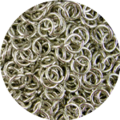 Description: Silver color, bright and very shiny. The aluminum we sell is actually referred to as bright aluminum (regular aluminum is not nearly as shiny and results in lots of black rub off within minutes of working with it!)
Description: Silver color, bright and very shiny. The aluminum we sell is actually referred to as bright aluminum (regular aluminum is not nearly as shiny and results in lots of black rub off within minutes of working with it!)
Price point: $
Ease of use: Very easy to work with (great for beginners)
Durability: Because aluminum is so easy to manipulate, you give up a little in the durability department. Not as durable as other metals (such as Jewelry Brass, Bronze, Stainless Steel, and Sterling Silver.) Very light.
Maintenance/Life expectancy: Easy to clean if it gets dirty, just wash in soapy water to bring back the shine. Over time, aluminum will corrode slightly, losing a bit of shininess. It stops this process once its surface layer (very thin) has corroded.
Hypoallergenic?: Not necessarily hypoallergenic however, it is widely accepted that aluminum is very poorly absorbed through the skin, so you do not need to worry about metal toxicity.
Alloy: 5356
Temper: Full Hard
Composition: Aluminum: 92.9 - 95.3%; Magnesium 0.8 - 1.2%; trace amounts possible of Chromium, Copper, Iron, Silicon, Zinc Manganese, Titanium
Purchase (bright) aluminum on our base metals page.
Copper (COPP)
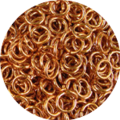 Description: Reddish finish, like a new penny.
Description: Reddish finish, like a new penny.
Price point: $$
Ease of use: Very easy to work with (great for beginners)
Durability: Not as durable as other metals (such as Jewelry Brass, Bronze, Stainless Steel, and Sterling Silver.) Has a nice weight. It is a weak metal, so you must be extra-gentle with copper chainmaille pieces, especially those with 20- or 22-gauge rings.
Maintenance/Life expectancy: Tarnishes fast. To clean, soak in pure lemon juice & salt for a few seconds. Store jewelry in Ziploc® bags to slow down tarnishing. Squeeze out as much of the air as possible from the bag before closing.
Hypoallergenic?: Some people do experience reactions to copper and other metals containing copper. This can result in skin turning green, etc.
Alloy: C110
Temper: 1/2 Hard
Composition: Copper: 99.9%
Purchase copper on our base metals page.
Jewelry Brass (JBRS)
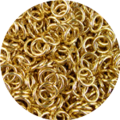 Description: Bright gold finish. Jewelry brass has a higher copper content than other brass. Some folks use other terms for jewelry brass, such as red brass, red bronze, or new gold, however note that those alloys may be exactly the same, or they may have 2-3 percent more copper.
Description: Bright gold finish. Jewelry brass has a higher copper content than other brass. Some folks use other terms for jewelry brass, such as red brass, red bronze, or new gold, however note that those alloys may be exactly the same, or they may have 2-3 percent more copper.
Price point: $$
Ease of use: Easy to work with (appropriate for most beginners.)
Durability: Durable and has a nice weight.
Maintenance/Life expectancy: Because it is an alloy of copper and zinc, brass patinas very fast. To clean, use any commercial jewelry cleaner that says it is safe for brass.
Hypoallergenic?: Because Jewelry Brass contains copper, people who have skin reactions to copper will likely also react to Jewelry Brass.
Alloy: C226
Temper: 1/2 Hard
Composition: Copper: 87%; Zinc: 13%
Purchase jewelry brass on our base metals page.
Bronze (BRNZ)
 Description: Close in color to copper (a little less red). If you like the look of aged copper but want a stronger metal, use bronze.
Description: Close in color to copper (a little less red). If you like the look of aged copper but want a stronger metal, use bronze.
Price point: $$
Ease of use: Can be challenging to work with, especially in 18g and 16g (not recommended for beginners.)
Durability: Durable and has a nice weight.
Maintenance/Life expectancy: Because this metal contains copper, it develops a patina fast. To clean, use any commercial jewelry cleaner that says it is safe for brass or copper.
Hypoallergenic?: Because bronze contains copper, people who have skin reactions to copper will likely also react to bronze.
Alloy: C150
Temper: 1/2 Hard
Composition: Copper: 92+%; Tin: approx 5% Phosphorus: 0.03 - 0.35% trace amounts of lead, Iron, Zinc
Purchase bronze on our base metals page.
Stainless Steel (SSTL)
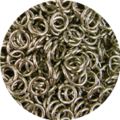 Description: Darker silver color, less of a mirror finish than aluminum but still shiny.
Description: Darker silver color, less of a mirror finish than aluminum but still shiny.
Price point: $$$
Ease of use: Can be very difficult to bend in gauges 18 and thicker. You'll need heavy-duty pliers (such as the Duck-Bill pliers. Steel is also fairly rough on pliers with Tool Magic; while the coating really helps keep your pliers from slipping, the coating starts to rip much sooner than with other metals. Saw-cut steel is expensive (it ain't easy cutting through steel with a saw!). This is NOT an appropriate metal for beginners, especially 18 and 16 gauge!
Durability: The most durable metal to work in and has a very nice weight.
Maintenance/Life expectancy: Steel will pretty much last forever and does not tarnish. Easy to clean if it gets dirty, just wash in soapy water to bring back the shine.
Hypoallergenic?: Stainless steel contains nickel, so those with nickel allergies often cannot wear stainless steel.
Alloy: 304
Temper: quarter-hard
Composition: Iron: approximately 69% Chromium: 19%; Nickel: 9.25%; Magnesium approximately 2%; Silicon: 1%; Carbon 0.08%; Phosphorous 0.045%; Sulfur: 0.03%
Purchase stainless steel on our base metals page.
What are the differences between your colored rings?
Blue Buddha carries 3 different types of colored metal: Anodized Aluminum, Anodized Niobium and Enameled Copper. Each has a different look, price point, ease of use, durability, maintenance regiment and life expectancy. Anodized aluminum and enameled copper are considered base metals and can be mixed and matched with the other base metals; anodized niobium is considered a precious metal and can be mixed with sterling silver. (Please also see the FAQ question "What colors are in each of your mixes?")
Anodized Aluminum (AA)
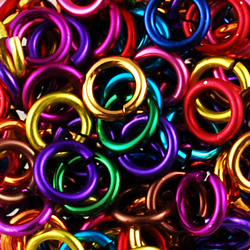 Description: Bright colors and shiny finish, anodized aluminum is the only pure metal ring that comes in black.
Description: Bright colors and shiny finish, anodized aluminum is the only pure metal ring that comes in black.
Price point: $
Ease of use: Like our aluminum rings, anodized aluminum is very ease to work with and is great for beginniners.
Durability: Similar to plain aluminum, easy to manipulate and therefore, a little less durable. Some anodized aluminum rings are weak (meaning they could pull apart easily), so be extra gentle. If the dye was not absorbed well, then it may begin to flake off at a stress point (generally the part of the ring directly opposite the opening) when you're working with it. Black is especially susceptible to this.
Maintenance: The color on anodized aluminum rings can be scratched by harder metals, so be careful when weaving and storing your piece. Oils from your skin may change the colors. Some of the color can be restored by washing the piece in soap and water.
Life expectancy: The color on anodized aluminum can last a long time with proper maintenance but, if worn very frequently, will not last forever.
Alloy: 6061
Temper: half-hard
Composition: Aluminum: 96.6 - 98.5%; Magnesium 1.5 - 2.1%; trace amounts of Chromium, Copper, iron, Manganese, Silicon, Titanium, Zinc
See available colors and purchase anodized aluminum.
Anodized Niobium (NIOB)
 Description: Beautiful, vibrant and unique colors with nice sparkle.
Description: Beautiful, vibrant and unique colors with nice sparkle.
Price point: $$$
Ease of use: Easy to work with but expensive. Not the best choice for beginners.
Durability: This is our strongest colored metal.
Maintenance: Oils from your skin may change the colors. Easily scratched, so be careful when weaving.
Life expectancy: The color on anodized niobium can last a long time with proper maintenance but may experience change or scratches over time.
Alloy: n/a (pure niobium)
Temper: half-hard
Composition: Niobium: 99.99%;
See available colors and purchase anodized niobium.
Enameled Copper (EC) + Enameled Silvered Copper (ECS)
 Description: Very shiny and offers the brightest colors of all our colored metals. The silvered colors are especially vivid because there is a layer of pure silver underneath the plastic "enameled" coating.
Description: Very shiny and offers the brightest colors of all our colored metals. The silvered colors are especially vivid because there is a layer of pure silver underneath the plastic "enameled" coating.
Price point: $$
Ease of use: Enameled copper can be challenging to work with not because it is difficult to manipulate but because it is very soft and it is very easy to chip the color coating. Not the best choice for beginners.
Durability: Very soft. When adding the plastic coating the metal becomes annealed, so it is soft. Enameled copper is actually the weakest metal we sell.
Maintenance: Enameled copper can be pulled apart easily and must be treated very gently. The color can chip easily so care should be taken when weaving.
Life expectancy: Due to the plastic coating on these rings, the color on enameled copper can last a very long time if treated gently.
Temper: Dead Soft (due to adding the coating)
Alloy/Composition: Proprietary. Coating is polyurethane and nylon blend.
See available colors and purchase enameled copper.
What colors are in each of your mixes?
UPDATED March 2016: Please see our Blog post Colorful Jump Ring Mixes For Making Chainmaille Jewelry for "recipes" for our anodized aluminum color mixes.
ANODIZED ALUMINUM MIXES

Berry Mix = Violet, Turquoise, Purple, Blue & Pink
Earth Mix = Blue, Turquoise, Green, Brown & Gold
Fire Mix = Red, Orange, Yellow & Gold
Persian Mix = Red, Orange, Gold, Brown & Black
Sky Mix = Blue, Turquoise & Aluminum
Water Mix = Blue Turquoise & Purple
Iridescent Gunmetal = Unlike our other mixes, this is not a mix of solid color rings but rather a color that contains many varying iridescent shades within a single batch of ring
Multi Mix = all colors available at the time the mix is made (no fewer than 7 in any given mix)
ENAMELED COLOR MIXES

Denim Mix = Royal Blue, Peacock Blue, Dark Blue & Ice Blue
Fire Mix *(discontinued) = Red, Orange, Yellow & Non-Tarnish Gold *(Sorry, this mix has been discontinued due to the Orange enameled copper wire being discontinued by the manufacturer)
Meadow Mix = Gunmetal/Brown, Bright Green, Lime & Dark Green
Merlin Mix = Lavender, Violet, Eggplant & Non-Tarnish Gold
Peacock Feather Mix = Peacock Blue, Violet, Bright Green, Eggplant & Non-Tarnish Gold
Persian Mix = Red, Amber, Gold, Gunmetal/Brown & Black
Sky Mix = Ice Blue, Peacock Blue & Non-Tarnish Silver
Multi Mix = all colors available at the time the mix is made
Can I combine base metal with precious metals?
Generally speaking, our artists and designers do not mix base metal and precious metal. There is just something about mixing expensive metals with inexpensive metals that our meticulous personalities just don't usually go for around here!
However, sometimes mixing metal types cannot be avoided. For example, if you'd like to use red jump rings in a sterling silver piece, you must use anodized aluminum or enameled copper, as niobium and titanium do not come in red.
Mixing and matching is completely up to you if you want to. If you enjoy the aesthetic or you feel your project calls for it - go for it! Making chainmaille jewelry is all about being creative. There are no rules. If it works, and you love it, it's right.
Choosing the Right Tools
The right tool for you depends on a variety of factors including ring sizes you are using, the material you are working with, and overall comfort and feel of the tools for your individual hands. This section of the FAQ will give you some general information about the differences between a few styles of pliers as well as information about products like Tool Magic.
What pliers do you recommend for different sizes/gauges of jump rings?
Choosing the right tools for any given project relies on many factors including ring size, wire gauge, metal and good ol' personal preference. We asked three of our chainmaille experts to share their favorite Blue Buddha pliers to work with in all the scenarios below. We hope these tables help you decide which pliers might be best for your next project. They should also begin to paint of picture of what each plier is really best for.
Happy Weaving!
Pliers recommended in this table: Euro Tool Ergo, Euro Tool Ultra Ergo Chain Nose, Lindstrom Rx
| 24g/22g/21g | Aimee | Kat | Rebeca |
| SILV | Lindstrom Rx or Ultra Ergo chain nose |
Ergos | Lindstrom Rx |
|
COPP |
Lindstrom Rx or Ultra Ergo chain nose | Ergos | Lindstrom Rx |
| JBRS/BRNZ | Lindstrom Rx or Ultra Ergo chain nose | Ergos | Lindstrom Rx |
|
SSTL |
Lindstrom Rx or Ultra Ergo chain nose | Ergos | Lindstrom Rx |
Pliers recommended in this table: Euro Tool Ergo, Euro Tool Ultra Ergo, Lindstrom Rx
| 20ga | Aimee | Kat | Rebeca |
| SILV | Ultra Ergo or Lindstrom Rx | Lindstrom in tight places, Ergo otherwise. | Usually non-coated Lindstrom RX in right hand; coated Ergo in left |
|
NIOB |
Ultra Ergo or Lindstrom Rx | Usually non-coated Lindstrom RX in right hand; coated Ergo in left | |
| ALUM/AA | Ultra Ergo or Lindstrom Rx | Lindstrom in tight places, Ergo otherwise. | Usually non-coated Lindstrom RX in right hand; coated Ergo in left |
|
COPP |
Ultra Ergo or Lindstrom Rx | Lindstrom in tight places, Ergo otherwise. | Usually non-coated Lindstrom RX in right hand; coated Ergo in left |
| JBRS/BRNZ | Ultra Ergo or Lindstrom Rx | Lindstrom in tight places, Ergo otherwise. | Usually non-coated Lindstrom RX in right hand; coated Ergo in left |
| SSTL | Ultra Ergo or Lindstrom Rx | Ergo | Usually non-coated Lindstrom RX in right hand; coated Ergo in left |
| EC/EC(S) | Ultra Ergo or Lindstrom Rx | Lindstrom in tight places, Ergo otherwise. | Usually non-coated Lindstrom RX in right hand; coated Ergo in left |
Pliers recommended in this table: Euro Tool Ergo, Euro Tool Ultra Ergo, Wubbers Medium Flat Nose, Lindstrom Rx, Lindstrom Ex, Tool Magic ("coated")
| 18/19ga | Aimee | Kat | Rebeca |
| SILV | Ultra Ergo or Wubbers Med | Lindstrom in tight places, Ergo otherwise. | coated Ergo |
|
NIOB |
Ultra Ergo or Wubbers Med | coated Ergo | |
| ALUM/AA | Ultra Ergo or Wubbers Med | Lindstrom in tight places, Ergo up to L size. After L = Wubbers for better balance | coated Ergos OR for larger rings (inner diameter P and up - 5/16" 7.9mm) coated medium or wide Flat Nose Wubbers |
|
COPP |
Ultra Ergo or Wubbers Med | Ergo up to L size. After L = Wubbers for better balance | coated Ergos OR for larger rings (inner diameter P and up - 5/16" 7.9mm) coated medium or wide Flat Nose Wubbers |
| JBRS/BRNZ | Ultra Ergo or Wubbers Med | Ultra Ergo, Lrg ring with High AR= Wubbers for better balance | coated Ergos OR for larger rings (inner diameter P and up - 5/16" 7.9mm) coated medium or wide Flat Nose Wubbers |
| SSTL | Ultra Ergo, Wubbers Med or Lindstrom EX | Rings up to size L = Ultra Ergo, after L = Wubbers | coated medium or wide Flat Nose Wubbers |
| EC/EC(S) | Ultra Ergo or Lindstrom Rx | Ergo |
coated Ergos |
Pliers recommended in this table: Euro Tool Ergo, Euro Tool Ultra Ergo, Wubbers Medium Flat Nose, Wubbers Wide Flat Nose, Lindstrom Ex, Duckbills
| 16ga | Aimee | Kat | Rebeca |
| SILV | Ultra Ergos for smaller sizes after size J then Wubbers Med or Wide | Ergo or Ultra Ergo up to size L. after L = Wubbers for better balance. | coated Wide Nose Wubbers |
|
NIOB |
coated Wide Nose Wubbers | ||
| ALUM/AA | Ultra Ergos for smaller sizes after size J then Wubbers Med or Wide | Ergo or Ultra Ergo up to size L. after L = Wubbers for better balance. | coated Wide Nose Wubbers or Ultra Ergos |
|
COPP |
Ultra Ergos for smaller sizes after size J then Wubbers Med or Wide | Ergo or Ultra Ergo up to size L. after L = Wubbers for better balance. | coated Wide Nose Wubbers or Ultra Ergos |
| JBRS/BRNZ | Ultra Ergos for smaller sizes after size J then Wubbers Med or Wide | Ultra Ergo up to size L. after L = Wubbers or Duckbills for better balance. | coated Wide Nose Wubbers OR for larger rings (inner diameter T and up - 3/8" 9.5 mm) I might use a coated Duckbill in my left hand and a coated Wide Nose Wubber in my right hand |
| SSTL | Lindstrom EX for smaller sizes after size J then Wubbers Med or Wide or Duckbills | Ultra Ergo up to size L. after L = Wubbers or Duckbills for better balance. | coated Wide Nose Wubbers OR for larger rings (inner diameter T and up - 3/8" 9.5 mm) I might use a coated Duckbill in my left hand and a coated Wide Nose Wubber in my right hand |
Pliers recommended in this table: Euro Tool Ultra Ergo, Wubbers Medium Flat Nose, Wubbers Wide Flat Nose, Duckbills
| 14ga | Aimee | Kat | Rebeca |
| SILV | Wubbers Med or Wide | Ultra Ergo or Wubbers for larger sizes. Have used duckbills for T14 (AWG) | coated Wide Nose Wubbers |
|
NIOB |
coated Wide Nose Wubbers | ||
| ALUM/AA | Wubbers, Duckbills | Wubbers, Duckbills | coated Wide Nose Wubbers |
|
COPP |
Wubbers, Duckbills | Wubbers, Duckbills | coated Wide Nose Wubbers |
| JBRS/BRNZ | Wubbers, Duckbills | Wubbers, Duckbills | coated Wide Nose Wubbers or Duckbills (or combination of both - Duckbill in left h and, and Wubber in right hand) |
Pliers recommended in this table: Duckbills
| 12ga | Aimee | Kat | Rebeca |
| SILV | Duckbills | ||
| ALUM/AA | Duckbills | Duckbills | Duckbills |
Which pliers are best for beginners?
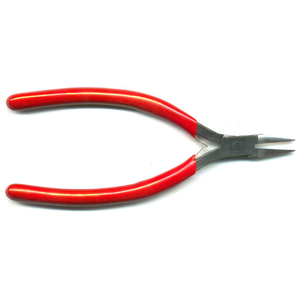
To make chainmaille, you will need two pairs of flat nose pliers with smooth jaws (no grooves) We generally recommend that people start with two Euro Tool Ergo or Ultra Ergo pliers because they are versatile and
affordable.
Check out the videos below for tips on how to properly open and close jump rings:
What are the differences between each model?
We sell different types of pliers for making maille and like them all for different reasons. On our tools page, you will notice that we provide information about which tools work best for different purposes.
 Euro Tool Ergonomic Pliers, flat-nose ($)
Euro Tool Ergonomic Pliers, flat-nose ($)
These EuroTool pliers are our all-around favorite pliers. The handles are longer than normal, but closer together. This means less carpel tunnel stress and more comfortable grip with less fatigue and better control. Recommended as "all-around" starter pliers. Particularly good when working with 20ga - 16ga base metals, 20ga steel, and 20ga - 15ga silver.
 Euro Tool Ultra Ergo Pliers, flat nose ($$)
Euro Tool Ultra Ergo Pliers, flat nose ($$)
This line from EuroTool features a truly ergonomic plier with handles that are slightly larger and straighter than most. These are suitable for a variety of gauges, from about 20ga to 16ga basemetal (20ga to 14ga sterling)—they're very good with 18g stainless steel. Increased handle width provides greater surface contact which means less fatique.
 Beadsmith Flat Nose Pliers ($)
Beadsmith Flat Nose Pliers ($)
These economical pliers are especially comfortable for folks with tiny hands. The ergonomic handles distribute pressure well; your thumb and index finger can rest nicely in the curves at the top of the handles.
 Wubbers Medium Flat Nose Pliers ($$$)
Wubbers Medium Flat Nose Pliers ($$$)
These are our favorite jaw-width for all-purpose chainmailling—not too small, not too large. Super comfortable pliers with padded handles and a very responsive spring. These pliers are recommended for heavy wire gauges (such as 18ga-12ga). They are Rebeca's favorite for working with 18ga stainless steel.
 Lindstrom Rx Pliers, flat-nose ($$$$)
Lindstrom Rx Pliers, flat-nose ($$$$)
Without a doubt, the most comfortable pliers we've used. Ergonomic handles mean that your palms aren't subjected to excessive pressure. The spring is adjustable; on the easiest setting a light squeeze is all it takes to work the pliers. These pliers are essential if you're going to be working with small rings. As soon as you use them, you'll understand the price tag, and know that they're worth every penny. Perfect for micromaille (size AAA24) and 22ga-20ga. These pliers also work well for many 18ga and 16ga rings (the jaws aren't very wide, so we don't recommend using these for rings with large inner diameters, such as P16.
 Duck Bill Pliers ($$)
Duck Bill Pliers ($$)
These pliers were custom made specifically for Blue Buddha and Spiderchain Jewelry. They are perfect for working with large rings, and are Rebeca's favorite for 12ga anodized aluminum and 10ga sterling. She sometimes even uses them to work with large 16ga stainless rings, as the pliers have really great leverage.
What is a Jump Ring Tool and how do I use it?
 Some chainmaillers prefer to use a combination of tools when weaving, for example one pair of pliers and a jump ring tool.
Some chainmaillers prefer to use a combination of tools when weaving, for example one pair of pliers and a jump ring tool.
Most people who like the tool use it primarily for pre-opening rings. Slip the jump ring tool onto the index or middle finger of your non-dominant hand. Use the pliers in your dominant hand to scoop up a jump ring. Still holding onto the ring with your pliers, insert the ring into one of the grooves in the jump ring tool. Then rotate your finger (with the jump ring tool) and the pliers in opposite directions to open the jump ring.
Other maillers also use the ring for closing, but this can become difficult if you are trying to add a weave to a very dense weave and there isn't enough space for the jump ring tool.
What is Tool Magic and how do I use it?
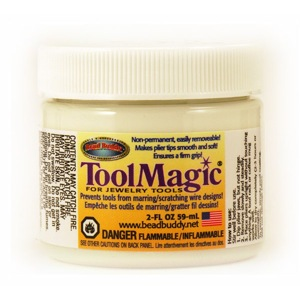 Tool Magic is a product used to coat the metal tips of your pliers. We highly recommend dipping your pliers in Tool Magic! Not only does it help you grip the rings but it protects your rings from scratches caused by your pliers (and for that matter it helps protect your hands from potentially painful grip-slipping injuries.)
Tool Magic is a product used to coat the metal tips of your pliers. We highly recommend dipping your pliers in Tool Magic! Not only does it help you grip the rings but it protects your rings from scratches caused by your pliers (and for that matter it helps protect your hands from potentially painful grip-slipping injuries.)
We prefer dipping the pliers twice, as two thin coats seem to last longer than one thick one. After your first dipping, let the pliers dry for a couple of hours by resting them on a flat surface—jaws suspended over the edge. Then dip again. Let dry overnight, or for a minimum of 6 hours, for best results. When the coating gets grubby, or if you decide you don't like the coating for the rings you're using, simply pull it off.
If your Tool Magic is thick, instead of dipping the pliers, we recommend using a shiskabob skewer (or similar utensil) to spread on a thin coat, making sure to cover the edges well. After letting it dry for a few hours, apply a second thin coat.
Check out the video below to see how to use Tool Magic in 3 easy steps:
Here are some extra helpful tips:
- Before dipping our pliers we always stir the Tool Magic, with a plastic utensil or chop stick that can be reserved just for this purpose.
- Dip the tips of the pliers in a fast motion. If you hold the pliers in the Tool Magic too long the coating will come out to thick.
- Let the pliers dry for at least one hour with the first coating. Then when you do the second coat you can let it dry for several hours or over night. The longer you let the second coat dry the better and longer it will adhere to the pliers.
- Make sure you only squeeze down on the pliers with enough force to open and close the rings. Applying to much pressure can cause the Tool Magic to wear off faster or mar the rings.
How do I thin out my clumpy Tool Magic?
How to thin out clumpy Tool Magic: Sometimes your Tool Magic will start to get clumpy as it gets used up and closer to the bottom of the jar. You can use a product called Naptha to help thin out your Tool Magic, which is a type of paint thinner. Just use a very small amount to start, you can always add more if your Tool Magic is not thinned out enough yet.
You can buy Naptha at home improvement or hardware stores for usually around $8.00 a quart. We recommend using this product in a well ventilated area, and to read the warnings on the Naptha container.

What is a bead mat and how do I use it?
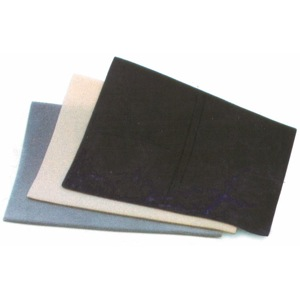 Bead mats were (not suprisingly) originally intended for use by beaders. However, the mats are just as useful for chainmaillers! They do a great job of keeping your rings from escaping when you dump them out and can help you weave more quickly by allowing you to scoop up rings with a jump ring held in your pliers (see image below).
Bead mats were (not suprisingly) originally intended for use by beaders. However, the mats are just as useful for chainmaillers! They do a great job of keeping your rings from escaping when you dump them out and can help you weave more quickly by allowing you to scoop up rings with a jump ring held in your pliers (see image below).

Check out the video below to see how using a bead mat can help you weave more quickly:
Chainmaille Project Help
Choosing the right project for you is half the battle. Chainmaille projects definitely range from very simple to very difficult and choosing a project that is the right level for you is important. Once you find a project you want to make, buying the right supplies can also be very challenging. This section offers help in finding projects and figuring out what supplies you need.
What projects are best for beginners?
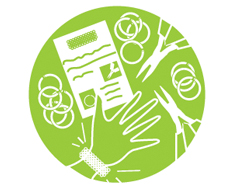
To get everything you need to get started, try one of our Starter Packs. Each packs comes with projects and instructions that are perfect for beginners as well as information about basic chainmaille technique.
Buy a chainmaille Starter Pack.
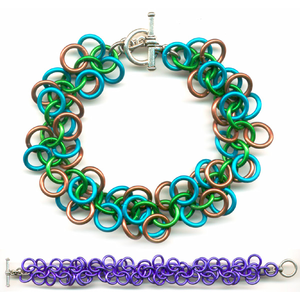
We offer instructions for nearly a dozen chainmaille projects perfect for someone just starting out. Blue Buddha instructions are full color and offer a detailed photograph for every step. They are about as close to an in-person class as you can get on paper and a few are even free! Many project instructions also have a coordinating kit that will allow you to get started right away without the guesswork of shopping for supplies. Your maille kit will come with everything you need to complete the project, including any necessary findings and components.

We also highly recommend Rebeca's book CHAINED to people just starting out in chainmaille. Not only does the book have several projects appropriate for beginners but it is the most comprehensive chainmaille book available when it comes to techniques and technical information about the craft. Because CHAINED has projects for every level, it will also grow with you from the first time you pick up your pliers to when you are ready to invent your own variations!
Does Blue Buddha Boutique sell kits and instructions?
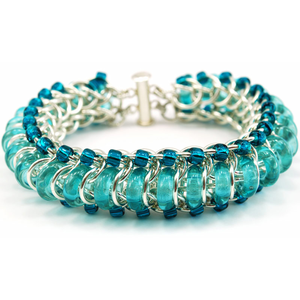 Yes, Blue Buddha Boutique sells full-color, easy-to-follow chainmaille instructions and jewelry kits for dozens of projects so you can learn how to make chainmaille jewelry. We offer kits and instructions for every level: introductory chainmaille projects to expert maille patterns. Our kits contain everything you need to complete the piece including any necessary findings and other components. Our instructions also list all the ring sizes and ring counts need for the project to make shopping for supplies á la carte quick and easy.
Yes, Blue Buddha Boutique sells full-color, easy-to-follow chainmaille instructions and jewelry kits for dozens of projects so you can learn how to make chainmaille jewelry. We offer kits and instructions for every level: introductory chainmaille projects to expert maille patterns. Our kits contain everything you need to complete the piece including any necessary findings and other components. Our instructions also list all the ring sizes and ring counts need for the project to make shopping for supplies á la carte quick and easy.
Please note that we sell kits and instructions separately. For more information about why we do this, please visit our “About our Kits” page.
"I am amazed at how fast you ship my orders. The instructions are easy to follow and the finished pieces get so many compliments."
-Jody W.
"I love how clear, simple and colorful your instructions are. I have purchased jump rings from others and yours have been the best in quality and price."
– Rosalia M., Kissimmee, FL
"Your check out system is so easy and love the way the instructions pop up after you return. thanks so much. look forward to receiving my kits."
– Shirlee O., US
"Thanks Blue Buddha for left-hand chain maille instructions!"
-Kimala F., US
"The instructions I ordered are clearly written and presented very nicely in the clear cover. Silver jump rings look great, can't wait to use them."
– Melinda F., US
"I am new to chainmaille. Your instructions are so easy to follow that I've exhausted my supply of rings!"
– Ryane W., US
"Love everything I have purchased. Instructions are easy to read and help is readily available. You guys are the best!!"
– Sheryl G., US
For more customer comments and to leave one yourself, see our Guestbook page.
Why do you charge for your instructions?
We receive a lot of feedback about our instructions - usually in the form of customers saying, "Blue Buddha instructions are the only instructions I can follow!" That said, some folks ask us why we don't give the instructions away for free. For that reason, we'd like to let you know a little more about why the prices are what they are.
Most of our tutorials take a minimum of 20 hours to produce and involve many professionals from chainmaille designers to photographers and graphic designers. Sure, we could try to scimp on these elements, but we know the product would suffer. Read on for more information about the journey each of our tutorials goes on before it is made available.



Each tutorial starts out with one of our project designers. These artists are crucial to offering you unique projects and we couldn't create these products without them. We recognize this, which is why we pay our designers royalties much as would be done if they'd published a book. This means that a portion of the fee you pay for our instructions goes directly to the artist who created that tutorial. Pretty cool, right?
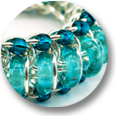
Once a project is created, it must be tested until it's perfected and then "deconstructed" to determine the best means to teach it. Once a method is determined, the writing begins. Take a second and think about how you would try to explain a chainmaille weave to someone...on paper. You guessed it - this stage is tricky and takes time!
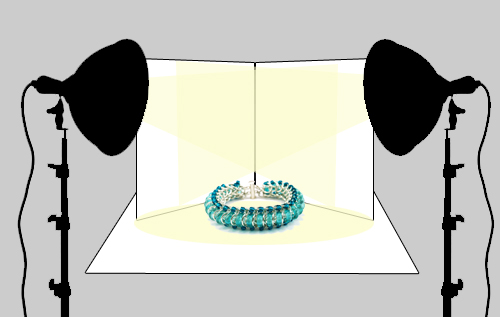 Once the writing it complete, each step is professionally photographed using photo-studio-quality lights and other equipment crucial for acheiveing our crisp, well-light step-by-step photos. The photos are then individually retouched to make certain every ring is very visable and our graphic designer adds arrows to many steps to clearly illustrate ring paths.
Once the writing it complete, each step is professionally photographed using photo-studio-quality lights and other equipment crucial for acheiveing our crisp, well-light step-by-step photos. The photos are then individually retouched to make certain every ring is very visable and our graphic designer adds arrows to many steps to clearly illustrate ring paths.
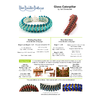 Finally, the whole thing gets laid out and edited a first time. We said "first time" because the journey doesn't stop here. Tutorials are ALWAYS tested before they are made available for sale, often by several people ranging from novices on our staff to expert maillers depending on the skill level of the project. This testing does cost more time and money (as well as supplies) but it is invaluable to the quality of our intructions. It allows us to identify the most universally successful way to explain the project - probably why we get a lot of compliments on our tutorials from happy maillers!
Finally, the whole thing gets laid out and edited a first time. We said "first time" because the journey doesn't stop here. Tutorials are ALWAYS tested before they are made available for sale, often by several people ranging from novices on our staff to expert maillers depending on the skill level of the project. This testing does cost more time and money (as well as supplies) but it is invaluable to the quality of our intructions. It allows us to identify the most universally successful way to explain the project - probably why we get a lot of compliments on our tutorials from happy maillers!
Once testing is complete, more edits are made and finally, the tutorial is finished. Phew! It is quite a process but it's all of these steps that go into making B3 tutorials outstanding.
Think about purchasing patterns at a fabric or yarn store - it's a similar concept to what we do at Blue Buddha. You don't get the patterns for free simply because you are purchasing supplies, and it's the same thing when you buy from us. We're not nickel and diming you; we're supporting artists and running a business. Do you like to get paid for the work that you do at your job? Well, we do too. ;-)

One more item of note - we not only allow but encourage people to create our projects and sell them on their own. To us, it is a very low investment to spend $6-$10 to learn a project that you can then turn around and make for profit!
Even if you are just making this for your own pleasure or for gifts ... we consider it a small investment for something that you can enjoy for the rest of your life. (Not to mention that they should save you from having to buy new valuables after throwing your pliers/pieces across the room in frustration - yes, we've been there too.)
Do you recommend buying chainmaille jewelry books?
 Yes, we do recommend chainmaille books! There are a variety of chainmaille books available that contain lots of inspiring projects. We sell a handful of books including CHAINED, written by Blue Buddha owner and founder, Rebeca Mojica. CHAINED contains projects for every level, beginner to expert, and offers ideas for many variations. Ring sizes in CHAINED are listed using Blue Buddha naming conventions, so shopping for supplies is a snap, especially via our Ringpicker page. We also sell kits for every project in the book.
Yes, we do recommend chainmaille books! There are a variety of chainmaille books available that contain lots of inspiring projects. We sell a handful of books including CHAINED, written by Blue Buddha owner and founder, Rebeca Mojica. CHAINED contains projects for every level, beginner to expert, and offers ideas for many variations. Ring sizes in CHAINED are listed using Blue Buddha naming conventions, so shopping for supplies is a snap, especially via our Ringpicker page. We also sell kits for every project in the book.
If you see a project in a book other than CHAINED, you will need to translate the ring sizes listed into Blue Buddha ring names. Our ring sizes chart will be a helpful tool for this. Additionally, please note that our interns test many book projects and we post their samples as well as supply lists in our Weave Samples album on our page on Facebook. If you come across a project we have not yet tested, contact us. Our interns LOVE to test projects to help you save time and money.
What about magazine projects?

Several jewelry-making magazines such as Bead&Button Magazine, Art Jewelry Magazine, Step-by-Step Wire Jewelry, and Wirework Magazine regularly feature chainmaille projects, including many by Blue Buddha ambassadors.
For your convenience, Blue Buddha has a page dedicated to supply lists for popular magazine projects. We only provide kits for a select number of projects by B3 designers, so generally speaking, we do NOT have kits for most magazine projects. To purchase rings for projects in magazines have your shopping list handy and visit our Jump Ring Picker page.
If you come across a project we have not yet tested, contact us. Our interns love to test projects to help you save time and money.
If you'd like to design a tutorial and see it published, find out how to submit a project to magazines.
Step by Step Wire
B3's founder Rebeca is a contributing editor for Step by Step Wire Jewelry magazine, and she would love to hear what you have to say about their chainmaille projects and share your suggestions with the editors. Are there any patterns you're dying to see instructions for? Do you have a favorite designer who you think should create a tutorial? What do you think about the selection of projects in the most recent issues? Please send any feedback about this magazine to [email protected]
Where can I buy supplies to make a project I saw in one of your ads?
We are in the process of a creating a special "As seen in our ads!" page with links to projects and products featured in our ads. In the meantime, many of the projects you seen in our ads can be found in our Projects section.
Look on our Supplies page for loose jump rings, tools, clasps, specialty beads and findings. Use our convenient Ring Picker tool to find all the jump rings you'll need for a project all on one page.
If the project shown is billed as a winner of our Featured Product of the Month contest, then we do not have kits for that item, and it's possible we might not sell all the components needed to make the item. Check the relevant posts on our blog for more info about the winning entry.
Can I find chainmaille projects online?
 In addition to our massive library of downloadable chainmaille jewelry patterns, Blue Buddha has free chainmaille instructions for several projects, including Wiggle (Mobius), Shaggy Loops and Double Spiral.
In addition to our massive library of downloadable chainmaille jewelry patterns, Blue Buddha has free chainmaille instructions for several projects, including Wiggle (Mobius), Shaggy Loops and Double Spiral.
In addition, many of our customers use free projects on other websites. However, this may not be the best route for beginners, as online instructions tend to be a bit less reliable than other sources. If you are interested in looking for projects online, we recommend checking out Maille Artisans (M.A.I.L.)*, CGMaille.com and YouTube. We also post intern samples with ring sizes for some online projects (like the Hourglass Dodecahedron sample at left) in our Intern Samples album on our page on Facebook.
* Note: you can set your preferences on Maille Artisans to display ideal ring sizes using Blue Buddha naming conventions. Visit our blog for step-by-step instructions on how to do this.
How many rings do I need for my project?
Like the question “What size rings do I need?” the answer to this question depends on what you are making. Blue Buddha instructions include ring counts for your convenience, as does Rebeca’s book CHAINED. Most projects published in books or magazine will give you either the total number of rings used for each size used in the project or the RPI (rings per inch). If given the RPI, simply multiply the number by the length you’d like your final piece to be. We recommend rounding up a bit on that number when you go to determine what pack size you want to buy – it’s always better to have some extra rings left over than not enough to finish your project.
If you are interested in tackling a common weave, try the Weave Ideas section of our blog. There, we post photos of weave samples made with several of our most popular sizes and include ring counts for each one. We also have a page dedicate to ring counts for weaves using sterling silver jump rings.
Do you sell clasps, findings, and other components for my project?
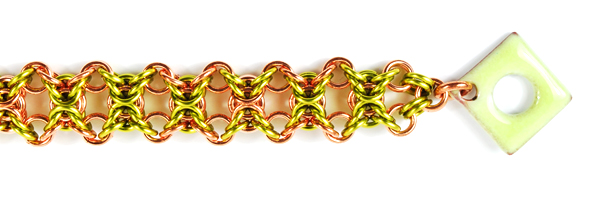
Yes, we offer several styles of toggles and other clasps as well as findings and other components that will take your chainmaille to the next level. Visit our Findings page to see our selection. When it comes to choosing a finishing touch for your piece, we recommend you consider size, finish and material. Choose something that compliments the piece you’re making. We even made a blog post dedicated to advice about choosing findings to match our colored rings.

If you are interested in learning how to add components such as glass and crystal rings, beads, or scales to your project, we highly recommend choosing one of our chainmaille tutorials that use these components. Our shaggy scales tutorial is even free!
You may notice that we do not offer a wide variety of beads. It’s true, we don’t and we don’t intend to. Our focus remains targeted on chainmaille supplies, we do not intend to compete with bead stores, and we hope you'll eagerly support your local bead shop (tell 'em Blue Buddha sent you!). However, as we fall in love with certain components that work particularly well with maille, these parts will find their way to our findings page *grin*.
I have my supply list, now what?
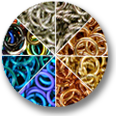 If you have a supply list for a chainmaille project in hand, we highly recommend using our Ring Picker Tool to select and purchase jump rings.
If you have a supply list for a chainmaille project in hand, we highly recommend using our Ring Picker Tool to select and purchase jump rings.
Simply choose the size you need in the first column. The next column will display all the in-stock metals we have for that jump ring size. Choose the metal you’d like to work with, pick colors as necessary, select the quantity desired, and add to your cart. You can select all the rings on your list right from the Ring Picker page!
I'm having trouble with a particular weave. Can you help me?
We strive to create crystal clear instructions, but because everyone learns in a different way, we know that sometimes folks will have questions. While we are happy to answer quick questions, we are unable to provide detailed one-on-one guidance as part of the price of our tutorials. Consider asking for help on our page on Facebook, as there are hundreds of other maillers who might be eager for the chance to use their knowledge to give you a hand.
Should you have lots of questions about different projects, or if you'd like one of our experts to help you learn a weave, set up a Private Lesson with us. If you live out-of-state (or are unable to come in during our limited hours), we also offer private lessons via Skype at the same rates as our in-person private lessons. Please contact [email protected] to set up your session.
If you're struggling with a project from a magazine or book, please contact the author directly for assistance.
What sizes do you use to make the Quantum Rose?
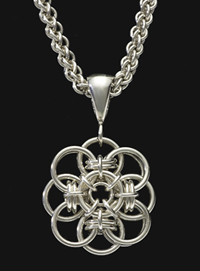 Ah, of course you are drawn to Rebeca's signature piece, the Quantum Rose. Unfortunately, this is one of the few designs that we will never teach or sell instructions for. It is one of her best-selling pieces, and we think there are just some secrets an artist should keep!
Ah, of course you are drawn to Rebeca's signature piece, the Quantum Rose. Unfortunately, this is one of the few designs that we will never teach or sell instructions for. It is one of her best-selling pieces, and we think there are just some secrets an artist should keep!
Blue Buddha began selling this design in 2003, and it is now sold through Rebeca Mojica Jewelry. We appreciate that the chainmailling community respects our decision not to divulge sizes. We are glad that folks aren't reverse-engineering the Quantum Rose and selling them. Thank you, chainmaillers—you know you're the best crafters out there!
We are happy to provide ring sizes for just about anything else on our website. Many sizes are listed in the kits and instructions section, or in the sterling or base metal stats pages, but if you don't find what you're looking for, let us know and we'll see if we can help.
About Our Rings
We specialize in top-quality chainmaille supplies, which means we only sell the best products we can find or produce. If we wouldn’t use them for our own projects, we won’t sell them.* All of our products are put through rigorous quality control. This ensures our jump rings are precision-sized and flawless, our findings are functional and beautiful, and our other components show no signs of imperfection. This section answers some of the questions we hear most often about our jump rings.
*Well, occasionally we'll offer some less-than perfect items on our sale page. :-)
If you are confused about our ring naming system, see What do your ring names mean? in the Ring Sizes section.
Do you make your own rings?
For the most part, yes. We work with a select number of expert chainmaillers and ringmakers across North America who are willing to abide by our very strict quality standards. If you're a perfectionist who makes your own rings, and you are interested in being considered for a ringmaker position, please send an email to [email protected] outlining your qualifications and experience with jump ring manufacturing.
We'll keep your information on file and when we have an opening, you'll be the first to know!
Note that our most popular offerings, anodized aluminum jump rings, are 100% Made in the USA. We do not yet have the space to make our rings in-house, so we the wire we purchase from a local facility is drop shipped directly to our ringmakers.
Do you anodize your own rings?
We anodize our niobium jump rings in-house as electricity is the only thing needed to achieve the beautiful range of colors.
 We send our anodized aluminum rings to one of the most innovative anodizing companies in the country for processing. To learn more about the aluminium anodizing process, check out the following blog posts:
We send our anodized aluminum rings to one of the most innovative anodizing companies in the country for processing. To learn more about the aluminium anodizing process, check out the following blog posts:
Color variation is just a fact of life.
Are your rings saw-cut?
Yes, our jump rings are saw-cut and have flush ends. Saw-cut rings are superior to pinch or machine-cut rings because, when closed perfectly, the seam is virtually invisible. Our head designer and company founder Rebeca Mojica overwhelmingly prefers to use saw-cut rings in her creations.
The only exception is AAA24 SSTL (24ga 1/16", 24ga 1.6mm). If these rings were cut with a saw, the kerf would be too large and once the jump ring was closed, it would be decidedly oval-shaped rather than circular.
Do you sell wire?
At this time, we are not set up to sell wire. We hope to be able to offer this option to our customers in the future.
Understanding Our Pricing
Many of our pack sizes offer built in discounts (as you purchase more rings, the per-ring cost is lowered.) We also offer Mix 'n' Match options for some of our anodized aluminum ring packs. Additionally, we offer Volume Discount pricing for orders more than 10,000 rings.
How does your pricing system work?
Our ring pricing depends on the type of ring you buy:
Base Metal
Aluminum, Anodized Alumium, Copper, Jewelry Brass, Bronze, Stainless Steel - These are sold in various pack sizes ranging from 50 pieces to 1,000 pieces. (A few of the larger jump ring pack sizes are smaller, with as few as 5 pieces for our size X12 jump rings.)
The larger the ring pack you purchase, the less expensive the per-ring price. The packet prices include these built-in savings. Purchasing a pack of 1,000 rather than twenty 50 packs saves you about 44%.
Enameled Copper - Sold in various pack sizes ranging from 50 pieces to 500. The larger the ring pack you purchase, the less expensive the per-ring price. The packet prices include these built-in savings. Purchasing a pack of 500 rather than ten 50 packs saves you 32%.
Precious Metals
Sterling - Due to the high cost of silver, these are the only rings that we sell individually. The per-ring price drops substantially if you purchase in a pack of 50 or 100 rings. The 100-piece pack is exactly twice the price of a 50-piece pack. If you purchase a 250-piece pack, you'll save about 7.5%
Niobium - Sold in packs of 50, 100 and 250. The price for a pack of 250 rings includes a built-in savings of about 15%. Note the different price levels for unanodized niobium (least expensive), niobium color blends and our premium solid-color packs.
Mix 'n' Match Discount
If you purchase our larger pack sizes (mainly 250- and 1,000-piece packs, or any pack size in silver and niobium), you qualify for automatic Mix 'n' Match savings ranging from an additional 5% - 40% off those packs, depending on the metal and number of packs purchased. You'll be able to see these discounts as you add items to your cart! Read more on our Discounts page.
Do you offer any discounts?
Yes! We offer a variety of discount programs to meet the needs of a wide variety of maillers. Whether you are a hobbiest getting rings for a few different projects, a designer stocking up to complete an order, or a store looking to sell our product, we have a program that will meet your needs. Read more on our Discounts page.
Do you wholesale?
Different customers have different interpretations of "wholesale" so we'll try to cover all our bases here.
"Wholesale" Pricing
Resale - For stores, we offer pre-packaged rings in small quantities (usually 100 pc or 250 pc). These rings are neatly packaged and quality-controlled for resale, allowing you to sell the rings at prices comprable to those listed on our website. We also package most of our kits for resale purchasing. You must provide Blue Buddha with a copy of your business license and your tax ID certificate in order to join our resale program. Please contact us if you are interested in finding out about how purchasing our rings for resale can help boost your store's sales.
Bulk - This new program is set to launch in 2013/14 and will allow any customer to receive substaintial savings on non quality-controlled Anodized Aluminum purchased by weight.
Mix 'n' Match - If you are an individual or store who just wants to purchase several of our larger packs of jump rings, your order will qualify for Mix 'n' Match discounts. Read more about this in our Discounts page.
Tax-Free Purchases
Illinois Businesses - Customers who live in IL must provide a valid resale certificate in order to purchase items tax free via the Internet or phone. Blue Buddha must have a physical or digital copy of your tax ID certificate before you pay for your order, otherwise you will be charged tax.
Non-Illinois Businesses - According to current tax laws, out-of-state customers do not need to provide any certificates. Please note that tax-free purchases have nothing to do with whether or not you receive a volume or bulk discount.
Can I use my tax id to get a discount on my entire purchase?
No, tax IDs do not give you any discount on our products. Refer to Do you wholesale? for more information.
How can I make my order tax exempt?
Non-Illionis Businesses
If your business is not based in Illinois, you will not be charged sales tax. Online orders are set up to recognize all out-of-state and international orders as tax-exempt. If you place a phone order, we'll see your address and will know not to charge you sales tax. Easy as pie!
Illinois Businesses
Before Ordering
We need a hard or digital copy of your tax certificate in order for Illinois-based businesses and individuals to receive tax-exempt ordering status. In the event we are audited, we need to provide a copy of your Illinois tax certificate to the IRS. Rather than try to track you down two years from now, we'd prefer to keep your certificate neatly organized in our files. A stitch in time saves nine, and frankly, we'd like to do everything we can to be prepared for the tax man!
Even if you are one of our best customers, we can only exempt you from sales tax if we have a valid certificate on file. No exceptions.
Note that your tax ID comes from the state of Illinois and should be an 8 digit number such as 1234-5678. We do not accept FEINs for this purpose, as federal certificates have nothing to do with state sales taxes.
Placing Orders
Once we have your tax ID, we'll enter it into our database so you won't have to provide it again (until the certificate expires, at which point, we'll request a new one). When you place a phone order, we'll see that you're exempt and will create the order accordingly.
Right now our shopping cart does not allow us to distinguish between tax-exempt and non tax-exempt customers for online purchases, so if you pay online, you'll pay sales tax. Your order will come through our system with an alert flag (and just to be safe, you can write a note in the "special instructions" section). When we process your order, we'll refund the sales tax.
What happened to your volume discount program?
In order to better serve the marjority of our customers, our volume discount program has been replaced with our Mix 'n' Match program. Read more on our Discounts page!
Ordering Help
This section offers help with the ordering process. If you are unsure what to order, visit our Choosing a Chainmaille Project section
Can I view my previous orders online?
Yes! By creating a log in for our website with the same email you use to place your orders through PayPal, you can view past order numbers and dates, current order status and tracking information for your packages. Learn more about how to create your customer log in on our blog.
From your "My Account" page, you can also shop from previous orders as well as save your shopping cart and come back later!
What payment methods do you accept?
We accept all credit cards online through our merchant processor and through PayPal. If you have a PayPal account, you can also pay using your PayPal balance. You may also use PayPal's Bill Me Later® option.
For phone orders we accept Visa, Mastercard, American Express and Discover. We also accept money orders and personal or business checks (payable to Blue Buddha Boutique), however note that we must receive your check and it must clear before we ship your order. We can also generate your order over the phone and send you a PayPal invoice if you'd like.
For pickup orders, we accept all of the payment methods used for phone orders plus—of course—cold, hard cash.
For international orders, we accept credit cards online as well as Western Union payments.
What is your return policy?
UPDATE: As of March 2016, we are no longer accepting returns. ALL SALES FINAL.
How do I cancel an order?
You can cancel an order that is still in our studio. If we've already shipped your items, your order can no longer be canceled. As soon as you realize you'd like to cancel your order, please contact us.
How do gift certificates work?
Please refer to our Gift Certificates page for full details on how to purchase and redeem gift certificates.
Do you have a paper catalog?
At this time, we do not have a physical catalog. Our website lists all of the supplies that we sell.
As you can see from our list of green practices, we are very concerned about protecting natural resources and cutting down on paper use. This is why we publish our catalog online. We apologize to those customers who enjoy seeing products printed on a page and hope you understand our decision to not publish a full-scale catalog.
How do I place a phone order?
As of April 2016, we no longer accept phone orders. Please order all items through the Blue Buddha Boutique Etsy shop.
If you have questions about our products, please send those inquiries to [email protected].
Shipping Help
This section offers help with shipping questions. Many of your shipping questions may be answered by reading through the information on our Shipping page, which contains our current order processing times to help you estimate when your order will arrive. It also details our current available shipping methods for both Domestic and International orders. Still have questions? The Q&A below should help.
How long will my order take to arrive?
This varies on a number of factors, including:
- our current order processing time
- the size of your order
- the shipping method you choose
- the distance from our warehouse to the destination
For detailed information, and for current order processing times, see our Shipping Page.
Note: For future reference, you can always reach the shipping page by clicking on the banner below, which is found on every page of our website.
Do you ship all over the world?
Yes, Blue Buddha is proud to ship all over the world. Note that some countries have restrictions on what can be imported; please check with your country's laws to make sure that everything you are ordering is allowable by customs.
International shipments can be costly, depending upon the weight of your package, your country's location and the local custom laws. Read more about international ordering on our Shipping page.
About Blue Buddha Boutique
This section answers the most frequently asked questions we here about our business in general. To learn more about B3 and the people behind our business, visit our About page.
What do customers say about you?
We have the great pleasure of receiving love from our customers on an almost daily basis. Whether they were won over by our high-quality product, outstanding customer service or über-fast shipping, many become customers for life.
Read for yourself:
Our Guestbook
Reviews on Yelp
Blue Buddha on Facebook
What is your company history?
Blue Buddha Boutique was founded as a part-time hobby by Rebeca Mojica in 2003. Originally specializing in moderately-priced, beautiful, innovative chainmaille jewelry, the company soon became the Midwest's largest product and training supplier for amateur chainmaille jewelry makers, as interest in the craft skyrocketed.
In 2007, Rebeca incorporated Blue Buddha and hired her first employee. Within a few years, the staff grew tremendously and the business was moved out of Rebeca's spare bedroom.
In 2016 facing declining sales and increased costs, the company shut down. We will miss you all! :-)
You can read more about the company and founder on our About Page.
What does your company name mean?
Rebeca once had a blue glass vase that was vaguely bulbous. One day, while a friend was gazing at it, he commented, "That looks like a blue Buddha sitting over there." Rebeca loved the way it rolled off the tongue (she's a huge fan of alliteration) so she decided to use it as an online handle back in the early days of the Internet.
When she was starting the business, she contemplating incorporating "maille" or "chainmaille" into the businessname, but she realized that she might want to branch off into other media, she decided to stick with the alliteration and go with Blue Buddha Boutique.
Later she found out that the Blue Buddha is considered a medicine Buddha, or a healing Buddha. Rebeca likes that, because she definitely thinks making chainmaille is therapeutic.
Postscript: Although Rebeca continues to take classes to learn new and different techniques, she has firmly decided NOT to branch off into other media, at least not anytime soon. *grin*
How do you give back to your community?
The Blue Buddha Boutique is committed to making the world a better place, particularly through education.
Here are just a few of the organizations B3 has supported with cash or jewelry donations:
• Adler Planetarium & Astronomy Museum
• AIDS/Lifecycle
• Albany Park Chamber of Commerce
• Anti-Cruelty Society
• Chiaravalle Montessori School
• Chicago Tap Theatre
• Coalition for Pulmonary Fibrosis
• Lillstreet Art Center
• Pulmonary Fibrosis Foundation
• SHAC 7
• Stand Up For Pits Foundation
• UPRAA Hurricane Maria Relief Fund
Additionally, Rebeca has volunteered as a contributing editor to Step by Step Wire Jewelry magazine and spent many years as a volunteer member of the Chicago Craft Mafia to promote the DIY scene in Chicago and beyond. Finally, she spends a few hours a month talking one-on-one with other chainmaillers and crafters who would like to make a living at their craft.
We also believe it is important to nourish the Earth, so that we can still have communities to give back to! To that extent, we strive to be as green as we can be. Read our list of green practices.
Who is Zed?
 Zeddicus Z'ul Zorander is our company mascot. (Rebeca is one of his persons.) We are a serious business, but we know that life is short and we have to enjoy it. Zed helps us do that. His head also appears in all of our print and online advertisments. Sometimes we have contests based around people finding Zed in our ads, so keep an eye out for the lil' white and black guy!
Zeddicus Z'ul Zorander is our company mascot. (Rebeca is one of his persons.) We are a serious business, but we know that life is short and we have to enjoy it. Zed helps us do that. His head also appears in all of our print and online advertisments. Sometimes we have contests based around people finding Zed in our ads, so keep an eye out for the lil' white and black guy!
Zed does not visit the studio, as he is rather skittish. And fuzzy. (We know none of you want extra white hair added in your order!)
Chainmaille Classes
Teaching others to make maille has always been at the heart of Blue Buddha Boutique. Founder Rebeca Mojica has been teaching chainmaille almost as long as she's been making it, and has spent more than 1,000 hours showing people all over the world how to create wearable art out of little metal circles. Several of the best-known instructors in the field, including Vanessa Walilko and Kat Wisniewski, have studied chainmaille at B3 and have learned effective ways to teach this medium using Blue Buddha Boutique methodology.
Do you teach classes?
Yes! As of February 2013, we are now offering a variety of chainmaille jewelry classes at our Edgewater Chicago location. We offer classes for every level from novice to expert and will continue to grow our offerings throughout the year.
Visit our Classes page to see what's coming up and make sure to join our "Local Buddhas" email list to stay up to date on all the events, classes and crafty happenings going on at Blue Buddha Boutique.
How do I register for a class?
Visit our Classes page and click the "DETAILS" button to view the class you want to take. Clicking "SIGN UP" will take you to a form where you can initiate your class registration. After completing the form, you will be contacted by our Curriculum Director or a Customer Care specialist to complete your registration.
Please read our Class Policies before signing up for a class and feel free to send us an email at [email protected] should you have questions.
How do I schedule a private or small-group lesson?
We are currently revamping our class schedule as well as how we handle private and small group classes. We will add new information about these private lessons to our website soon. In the meantime, should you wish to schedule a private lesson, please email [email protected] or call our studio line at 866.602.RING (7564).
If you live out-of-state (or are unable to come in during our limited hours), we also offer private lessons via Skype at the same rates as our in-person private lessons. Please contact [email protected] to set up your session.
Do you teach out-of-state?
Almost all of our classes are in the Chicago area. Blue Buddha founder Rebeca Mojica usually teaches at the Bead&Button Show in Milwaukee WI each June. If you'd like Rebeca to teach at a specific Bead Show or out-of-state store, please email [email protected] with your request. If there is enough interest, we will try our hardest to set up a class or two at that location.
We are investigating the possibility of offering online classes in order to reach non-local students. We'll keep the website updated as we make progress on that front. In the meantime, you can set up a private or small-group lesson via Skype at the same rates as our in-person private lessons. Please email [email protected] for more information.
I want to learn something in Rebeca's gallery; can you teach me that?
Some of the items seen in photos on the website, or in Rebeca's gallery can be found in the classes section, in which case, yes, we can teach it to you!
If you don't see the item in the classes section, we might be able to teach it to you, but you may not receive a handout or any instructions if we haven't developed instructions for that particular design. There are a few items, such as our Quantum Rose, which we do not teach.
Please contact us if you don't see a class listed for the piece you'd like to learn.
I saw a chainmaille project in a book or a magazine; can you teach me that?
We respect copyright laws and the artists whose works appear in print. We will only teach a book or magazine project with written permission by the artist.
We encourage you to review our Magazine Projects Supplies page for a listing of Blue Buddha ring sizes that can be used for chainmaille projects in many magazines.
Do you sell kits and instructions for all the classes you offer?
If the project is not found in our Kits and Instructions section, or available as a sale PDF on our Sale page, then we do not have kits or instructions available for that particular project.
Please email [email protected] and let us know what projects you are most interested in, and we will develop new kits and instructions based on customer demand.
Finished Jewelry
As of December 2012, Blue Buddha's founder is selling finished jewelry under her own name - Rebeca Mojica. Many of the jewelry designs previously found in Blue Buddha's gallery will be available in Rebeca Mojica's shop or online gallery. See the questions below for more information, or hop on over to rebecamojica.com.
How do I care for my jewelry?
General care
- Keep jewelry away from household cleaners and chlorine.
- When not wearing your jewelry, store each piece in its own Ziploc® or soft fabric bag. Keep in a dark place. This reduces tarnish, keeps softer metals from being scratched, and preserves colored rings longer.
- Always handle your jewelry gently. Remember that most chainmaille links are not soldered closed, and can therefore be pulled open. Treat your chainmaille just as you would handle a delicate pearl necklace or crystal bracelet.
- Your jewelry can pick up dirt, oil, and even odors. To clean most metals (sterling silver, stainless steel, aluminum, titanium, niobium, and gold-fill), soak jewelry in soapy water (use non-lotion dishwashing soap) for several minutes. Then lather with soap and gently but briskly rub the jewelry between your palms. Rinse with warm water and let air dry, or use a blow dryer on lowest and coolest setting.
- You can polish most chainmaille in a tumbler. Use stainless steel shot, or simply add a bit of water and non-lotion dishsoap. If not using shot, make sure to tumble several pieces at once so that there is enough friction to shine the rings.
- Refer to the guidelines below for additional care and cleaning details for specific metals.
Aluminum
- Aluminum is a soft metal, so be extra gentle.
- Aluminum doesn't tarnish, but it will pick up oils and dirt, causing it to become dull. Follow cleaning instructions under General Care. Over time, aluminum will corrode slightly, losing a bit of shininess. It stops corroding once its surface layer has corroded.
- I use an alloy of aluminum known to maillers as Bright Aluminum. This alloy is shinier and stronger than regular aluminum. Some people may notice a black rub-off where the aluminum touches their skin. (How much of a rub-off may depend on the acid content of your skin; several people who have reactions to copper also react to aluminum.)
- It is widely accepted that aluminum is very poorly absorbed through the skin, so you do not need to worry about metal toxicity.
Brass
- Brass can tarnish quickly, and will corrode over time. Clean with any commercial jewelry cleaner safe for brass.
Bronze
- Bronze can tarnish quickly. Like Brass, bronze may also be cleaned with any commercial jewelry cleaner safe for brass.
- Bronze is an alloy of copper and tin, which is why aged bronze is nearly indistinguishable from copper. Bronze is, however, stronger than copper.
Colored Metals
- To create the brilliant colors found in my pieces, regular rings are dipped into electrically charged solutions. The electricity causes the outer layer of the ring to change colors. By varying the voltage, literally a rainbow of colors can be achieved. Niobium (element 41) and titanium (element 22) are anodized in this manner. Aluminum is anodized to prepare the metal, and then dyed.
- Anodized rings may fade with time. For most jewelry pieces this won't happen for a very long time. However, with pieces that often encounter high-friction situations (ie, finger rings), the process will happen faster. Storing your jewelry in a Ziploc® or soft fabric bag helps minimize discoloration. Of the anodized metals, titanium holds its color best.
- NEVER use polishing crèmes or cloths because they may remove the color from anodized rings. Follow cleaning instructions under General Care.
Copper
- Copper quickly turns from a shiny orange-brown to a deep chocolate color. Exposure to air and light speed this process. Leave your piece out if you want it to tarnish quickly. Otherwise, store it in its own Ziploc® bag.
- To clean tarnish: Soak it in white vinegar for 10-20 seconds. After removing the bracelet from the vinegar, lather with non-lotion dishwashing soap and water, and rub the jewelry briskly but gently between your palms. Rinse thoroughly. Pat dry with a towel or use a blow dryer on lowest setting. Make sure the piece is fully dry before you return it to its ziploc® bag.
- It is worth noting that repeated vinegar cleaning can strip rings of their luster as the procees creates microscopic pitting in the surface of the rings. This can be buffed out via tumbling, however if you don't have access to a tumbler, it is recommended to limit the use of this process.
- Copper is very soft, so be extra gentle with copper jewelry.
Gold-Fill
- Gold and Gold-fill rings may develop a subtle patina with time. Follow general cleaning instructions under General Care.
- Gold-fill is a layer of 12k gold surrounding a base metal core. This layer is 20% the thickness of the wire—about 1000 times thicker than gold-plating—so the gold won't flake off.
Stainless Steel
- One of the toughest metals around, Stainless Steel makes for extremely durable jewelry. I often add a few links of Stainless to my aluminum pieces (especially near the clasp) to give those pieces some extra security. Stainless doesn't tarnish and isn't easily scratched.
- Steel reacts to temperature changes quickly. Take care when cooking over a stove, washing your hands with hot water, and using a hair dryer. Steel requires little maintenance, but if you'd like to clean your piece, follow instructions under General Care.
Sterling Silver
- Silver tarnishes quickly when exposed to light and air. If you want your jewelry to tarnish, then leave it out when you're not wearing it. (Otherwise, store each piece in its own Ziploc® bag with an anti-tarnish tab. Remove tarnish regularly following cleaning instructions under General Care.)
- Avoid resting sterling directly on wood surfaces, especially oak, as wood finishes usually contain acids that can mar the surface of sterling. Always store silver away from direct sunlight.
Multiple Metals & Other Components
We often receive questions about caring/cleaning jewelry that combines metals, particularly pieces that combine anodized aluminum with other metals. It is fine to tumble pieces that combine AA with other metals, in fact that is our preferred method of cleaning. If you do not have access to a tumbler, you can clean pieces by hand using blue dish soap.
You can use the white vinegar method for cleaning pieces that combine tarnishable metals (copper, jewelry brass, bronze) with anodized aluminum. It is worth noting that repeated vinegar cleaning can strip rings of their luster as the procees creates microscopic pitting in the surface of the rings. This can be buffed out via tumbling, however if you don't have access to a tumbler, it is recommended to limit the use of this process. First and foremost, we recommend storing your pieces in airtight, ziplock baggies with anti-tarnish tabs to minimize the need for cleaning.
For information about caring for jewelry that combines jump rings with delicate components such as glass rings or crystals, check out this blog post!
How do I care for my rubber chainmaille jewelry?
Caring for rubber chainmaille pieces: Your rubber chainmaille should be conditioned monthly (or every couple of months if you are not wearing it and it is stored in a plastic container). Conditioning your rubber chainmaille piece will prolong its life and restore it to its original sheen. If you do NOT condition your rubber, it will crack, split and get a white haze.
DO NOT USE PETROLEUM BASED OILS to condition your rubber chainmaille. It WILL deteriorate over time. To condition your rubber chainmaille place the item(s) in a zip lock bag. Spray items 2-5 times with TIRE SHINE/ARMOUR ALL, a little goes a long way. After closing bag, place between your hands and rub them together (like you’re trying to warm them up) for roughly 30 seconds. Take your item(s) out of the bag and rinse them under *hot running water. Dry item(s) with a towel or rag. Do not air dry your rubber ring items, they will become sticky and will need to be rinsed and towel dried again.
*Note: If you have copper, jewelry brass or bronze rings combined with your rubber rings use cool water instead of hot. Hot water will begin the tarnishing process on those metals and they will tarnish much faster than usual. Also, be careful with colored metals and do not clean them too often in this way as it will speed up the fading process.
How can I commission a custom piece from Rebeca?
Blue Buddha founder Rebeca loves the challenge and creativity of designing pieces to suit your needs exactly. Please note that Rebeca is now selling finished jewelry under her own name, Rebeca Mojica.
To request a quote for a custom piece, please send an email to [email protected] or call Blue Buddha at 866.602.RING (7464) and describe the piece you're dreaming of. Rebeca will work to make your design a reality. She is happy to work with a wide range of budgets to create any form of wearable art, from short earrings to epic, one-of-a-kind necklaces.
How long does it take for an item of jewelry to be made?
This varies greatly, depending upon the complexity of the weave, how many jump rings are used the size and metal of the rings, and other similar factors.
A very simple pair of earrings from one of Rebeca's regular jewelry lines could take her less than 10 minutes to make. Complex pieces can take her more than 100 hours. Creating new pieces takes additional time beyond simply linking the rings together, as the design process (including troubleshooting sizes) can be time-consuming.
New weavers typically need three to ten times as long as veteran weavers to create pieces.
Can I find your finished jewelry at art fairs and craft shows?
Rebeca sells finished jewelry under her own name at a few shows a year, noteably the DIY Trunk Show and the One of a Kind Show & Sale.
Please visit the Events section of rebecamojica.com for a listing of upcoming jewelry shows. Note that Blue Buddha does not sell supplies at Rebeca Mojica shows. If you're looking for pliers, kits, jump rings and other supplies to make your own chainmaille, visit the Events section on this (Blue Buddha's) website.
Can I find Rebeca's designs in any retail stores?
Rebeca's line of chainmaille jewelry is currently sold exclusively through Blue Buddha Boutique's studio/warehouse in Chicago's Edgewater neighborhood, which is open by appointment only. Refer to our contact information for more details. To see designs available, visit the shop on rebecamojica.com.
Do you have a class or kit for items in Rebeca's gallery?
It's possible. Check our classes and supplies pages first to see if you see the item you're interested in. If you don't see the item there, it means we do not have a class or kit based on that project. We won't divulge the exact ring sizes of some designs (such as the Quantum Rose), but for many of our pieces, we are comfortable developing classes and instructions.
Feel free to request that we develop a kit by sending email to [email protected].
Chainmaille in General
Chainmaille has been around for about 3,000 years, but some people still think "chain letters" when they hear the term. *grin*
The "Chainmaille 101" Q&A below provides an overview to this resurging craft as well as a glossary of common terms and abbreviations.
What is chainmaille?
Chainmaille (also known as chainmail, or simply maille) is typically armor or jewelry made by connecting metal rings to one another. The word maille derives from the French word maille (mesh), which comes from Latin macula (mesh of a net). Creating something out of maille involves a few steps:
- Wrap metal wire around a rod to make a coil.
- Cut the coil, creating individual "jump rings."
- Using pliers, link the rings—one at a time—into a pattern.

Chainmaille is one of the earliest forms of metal armor. The oldest piece of maille armor that can be accurately dated is more than 2,700 years old. It was discovered in the graves of Celtic warriors. Earlier evidence of chainmaille has been found in graves from the 5th century BC in Scythia (an area between Europe and Asia). Although most historical chainmaille is armor, jewelry techniques were also used by cultures as diverse as the Vikings and the ancient Egyptians. It is difficult to trace the history of chainmaille, because much of the "evidence" was destroyed in battle. Many pieces that survive today may have been high-quality pieces passed on from generation to generation (or even stolen from a corpse after a battle). These may or may not be a good sampling of the most common maille used. Read more about the history of chainmaille at Wikipedia.
 Maille has become increasingly popular in recent years. Some artists make armor to use in staged battles. Others prefer to create chainmaille jewelry, and still others make sculptures. The versatility of this medium is astounding; artists have created chessboards, belts, dresses, baskets and even sunglass lenses (see closeup)—all out of maille.
Maille has become increasingly popular in recent years. Some artists make armor to use in staged battles. Others prefer to create chainmaille jewelry, and still others make sculptures. The versatility of this medium is astounding; artists have created chessboards, belts, dresses, baskets and even sunglass lenses (see closeup)—all out of maille.
Chainmaille can be made from virtually any material that can be formed into a circle. This includes most metals as well nontraditional jewelry materials such as rubber.
| The number of known patterns is impressive: More than 1,000 weaves are documented on M.A.I.L. (Maille Artisans International League). Most of these modify basic patterns, but each weave is distinct. Today's weavers still create new patterns, from simple chains to intricate, fabric-like sheets. |  Japanese Bulls-Eye, a weave by Rebeca Mojica |
Blue Buddha Boutique projects feature a variety of metals to best suit your tastes and budget. The most commonly used metals are sterling silver, copper, aluminum, stainless steel, niobium and titanium. Other metals include gold-fill, brass and bronze. By dipping certain metals in electrically charged solutions and varying the voltage—a process known as anodizing—dazzling colors can be created. Niobium and titanium are anodized this way, while aluminum is prepared, then dyed.
How many weaves are there?
Maille Artisans International League (M.A.I.L.) has a comprehensive library of chainmaille weaves, grouped by family, with free tutorials for many weaves.
There are more than 1,000 weaves listed on M.A.I.L. Whew! Note, however, that the majority of weaves are variations on a smaller number of basic weaves.
What are some common terms, industry jargon and abbreviations?
Common Chainmaille Definitions and Abbreviations
Anodized – An anodized metal is one that has been electrically treated. By dipping niobium or titanium in an electrically charged solution, an oxide layer is formed and the surface color changes. The colors achieved depend on the voltage. When aluminum is anodized, the oxide layer is clear, and the metal is then dyed. Whether the colors are electrically obtained, or dyed, the colors may vary from batch to batch and from ring to ring.
AR - Aspect Ratio. The relationship between the Inner Diameter and the Wire Diameter of the ring. The formula to calculate AR is ID ÷ WD High AR rings have a big hole with comparatively thin wire. You can fit a lot of similar jump rings through the hole of a high AR ring, so many weaves are possible, but many are far too loose to be aesthetically pleasing. Low AR rings have a small hole with comparatively thick wire. You can't fit a lot of rings through the center, so not many weaves are possible. For more information, see "What is Aspect Ratio?", "How do you calculate AR?" and "How do you use AR?"
AWG - American Wire Gauge – A numbering system that tends to be used for non-ferrous (meaning not containing iron) metals. This is what is traditionally used for sterling silver and copper. It's always best to ask your suppliers directly about the exact stats on their rings.
Base Metal – Normally a base metal is a metal that oxidizes or corrodes easily. For ease of grouping the non-precious metals into a cohesive group, B3's base metals refer to aluminum, bronze, copper, enameled copper, (jewelry) brass and stainless steel.
Calipers – A tool to measure the ID, WD and OD of jump rings. (B3 sells calipers in our Tools section.)
WD - Wire Diameter – The measured thickness of the wire used in a jump ring. Most commonly given in gauges, but since gauges are inconsistent (see AWG vs SWG), many maillers prefer to give WD in millimeters or decimal inches.
g, ga, or gu - Wire Gauge. Wire Gauge – (abbrv g, ga, or gu ) Gauges are numbers designating the thickness of the wire used to make the jump ring. Gauge systems differ according to the metal - 16ga steel is different from 16ga sterling (see AWG & SWG). The main thing to remember about gauges is that the higher the number, the thinner the wire. Most armor chainmaille is 12ga - 16ga. Jewelry tends to be 16ga - 22ga. Micromaille is 22ga - 24ga (and even thinner, for the hard-core micromaillers!). See the gauge conversion chart in the Jump Ring Sizes page for gauge measurements and conversions.
ID - Inner Diameter of jump ring – Typically given in millimeters or fractional inches. Best measured using calipers (to account for springback) when jump ring is closed.
Jump Ring – This is where it all starts: the basic ring from which traditional maille is created.
Kerf – The width of cut made by a saw through the jump rings. A thick saws yields a ring with a large kerf, and thin saws create rings with minimal kerf. Smaller kerfs are better, because the jump ring maintains more of its circular shape when closed if less metal is removed.
Mandrel – a rod around which wire is coiled in order to make jump rings. The standard ring mandrels used at B3 increase in 1/64” increments.
Möbius – A technique whereby multiple rings are intertwined, but they function as an individual unit.
OD - Outer Diameter of Jump Ring. The outside measurement of a jump ring, from one end to another. Traditionally given in millimeters or decimal inches. Best measured using calipers when jump ring is closed. Maille purists never give ring sizes in OD, however bead supply companies often use OD to measure jump rings, since they are accustomed to measuring beads in OD.
Precious Metal – Pecious metals are rare and of high economic value. On our website, we consider precious metals to be gold-fill, sterling silver, niobium and titanium.
rpi – This abbreviation means "Rings Per Inch" and is generally used for rope weaves to indicate how many rings of each size are used per inch, in order to help estimate number of rings needed to complete a specific length (for instance, for a bracelet or necklace). For sheet weaves, rpi may be listed as rings per square inch, as that measurement is more useful when trying to cover a large surface area.
Springback – When raw wire is wrapped around a mandrel, it "relaxes" a bit after being coiled because it prefers to stay a straight piece of wire. This relaxing is known as springback. Different metals have different springback. For example, a stainless steel jump ring wrapped around a 5/16 inch mandrel is significantly larger than a sterling jump ring wrapped around the same mandrel. This is because steel is tougher, and it springs back more. The same metal in different gauges wrapped around the same mandrel will yield different IDs, because springback differs depending on the gauge. Note also that different suppliers have different methods of wrapping, resulting in different springbacks even if wire gauge and metal is the same. Even if different suppliers use the same metal wrapped around the same mandrel, springback can be different if each supplier's wire is a different temper (see definition of temper below). Springback affects aspect ratio, so be sure to take springback into account when ordering rings.
SWG - Standard Wire Gauge – Also known as Imperial Wire Gauge. A numbering system often used for ferrous (meaning containing iron) metals. Stainless steel usually has SWG numbers. It's always best to ask your suppliers directly about the exact stats on their rings.
Split Ring – Similar to a jump ring, split rings are most commonly used for key rings. A split ring has a slit going the long way around its circumference, rather than the split cutting the short way through the wire. If you were to tug apart the ends of a split ring, it would resemble a very small spring.
Temper – The hardness or softness of wire. Softer wire is more malleable, and harder wire is stiffer and more durable. Typical tempers include Dead Soft, Half Hard, Full Hard.
Weave – (n) A specific pattern of rings. Weaves are divided into various families. (v) the act of linking jump rings together into a pattern
WD - Wire Diameter of jump ring. Most commonly given in gauges, but since gauges are inconsistent (see g, AWG & SWG), many maillers prefer to give WD in millimeters or decimal inches.
Weave Acronyms
CIR - Captive Inverted Round, a roundmaille variant by Lorenzo.
DS - Dragonscale, a complicated European weave.
FP - Full Persian. Often written as FP6-1 for Full Persian 6-in-1.
GSG - GSG is a Persian weave by Buddha. Named for the Great Southern Gathering where the weave was perfected.
HP - Half Persian. Usually seen as HP4-1 or HP3-1, etc. for Half Persian 4-in-1 and Half Persian 3-in-1.
How is it spelled? Chainmaille? Chain mail? Chainmail?
As noted in "What is Chainmaille?", the word maille derives from the French word maille (mesh), which comes from Latin macula (mesh of a net).
It is because of this etymology that B3's founder, like many other maillers, prefers to spell chainmaille with an “le” at the end, as opposed to using the traditional spelling of chain mail. Well, that, and to distinguish our beloved craft from chain letters. *grin* Spelling chainmaille with an "le" also allows for more precise image or text search results on the Internet.
Note that some chainmaillers prefer the term "maille" as they consider "chainmaille" to be redundant.
Throughout the years, we've seen all of these alternate spellings of chain maille used by those in the industry:
- chainmaille
- chain maille
- maille
- chainmail
- chain mail
- chainmaile
- chain maile
- maile
Note that we're actually petitioning the dictionary people to add "chainmaille" as an acceptable alternate spelling. In order to do that, we need to amass lots of press clippings that use the term as we spell it. So if you come across any such references, we'd greatly appreciate it if you could please forward to [email protected]!
P.S. Yes, you'll find that we occasionally write "chain mail" or "chainmail" on our website. It's not a mistake. We've used that spelling so that folks who are searching for those terms on the Internet will still find our website! :-)
For Crafters
Part of Blue Buddha's mission statement is to encourage entrepreneurship amongst artisans by promoting the DIY community and providing pro bono opportunities for crafters to learn about business issues. Whether you are simply making jewelry for you and your friends, or you are looking to achieve world domination with your chainmaille jewelry, we wish you much success in your chainmaille endeavours!
How do I price my jewelry?
by B3 founder Rebeca Mojica
Pricing is the eternal dilemna of crafters. Many people don't want to overcharge, so they wind up undercharging. In order to ensure you make enough profit, you should find a pricing system that works and use it for all your pieces. This article will show you one way to price your work in order to meet your expenses, pay yourself, and have money leftover to invest into the business.
For my jewelry, I've set up a spreadsheet so all I do is plug in the materials cost plus the time it took me to make the piece. The spreadsheet does its magic and gives me an estimate of how much I would make per hour (after profits, overhead and taxes) for that piece if I sold it directly to a customer and also if I sold it at a wholesale price. The hourly rate is important to me, because I spend time doing business-related tasks other than weaving. If I know how many hours a week I spend making maille, I can figure out what my hourly wage needs to be in order to cover the behind-the-scenes time when I'm not mailling. The spreadsheet comes in handy when I'm calculating the prices for new production items as well as when I need to give someone a quote for a custom piece.
If you don't want to set up a spreadsheet and are just looking for a formula, here is one possibility:
M + W + O + P = wholesale price
Materials – I highly recommend doubling your materials cost. This way, not only have you covered the cost of your piece, but you can reinvest in the materials to make another one.
Your Wages – Don't underestimate. Choose an hourly wage that will allow you to eat!
Overhead – Each piece has some overhead attached to it. Overhead includes office expenses, packaging materials, tools, etc. Figuring out a precise number is easier if you have a few months of data to look back on. Total your expenses, and divide by the number of months. Then divide by the number of hours you spend making jewelry each month. This gives you an estimation of your hourly overhead. So if that number winds up being $5.75, you should add about $6 to your hourly wage to cover overhead.
Profits – This number is very important; don't omit it! You will need to reinvest some of the money you make in order to keep making money. This allows you to purchase better tools, move from base to precious metals, replace a broken computer, etc.
| Here's an example: Sarah made a bracelet in 1 hour. The material cost was $7. She has not been making jewelry for long, and will probably only make jewelry as a hobby, so she sets her hourly wage at $10. Her overhead is $5 per hour, and she'd like to invest $5 back into her jewelry business so it can grow.
Double the wholesale price to find the retail price: $68 |
NOTES about Uncle Sam: The formula above doesn't include taxes. If you make more than $400 per year with your jewelry, you will need to pay income taxes. As a sole proprietor—most jewelers and crafters start out this way—you are NOT allowed to pay yourself a wage. The government assumes that all income (Revenue minus Expenses and materials cost) goes into your pocket, and this is what they will tax. A good rule of thumb is to assume the IRS will take 30% of your income. Keep that in mind when using the formula above! You may want to inflate the number for your hourly wage in anticipation of taxes.
COGS stands for Cost of Goods Sold, and this is an important number. It's the M in the pricing formula above. Let's say you spent $500 on jump rings. Common sense may tell you to deduct $500 right away as a business expense ... but that is incorrect. You cannot deduct raw materials—aka inventory—until you sell them, or sell a piece that uses them. When Sarah made the bracelet mentioned above, she deducted the materials cost at the time of the sale, not at the time of the purchase.
In reality, you only figure out the COGS at the end of the year, by closely counting your inventory. COGS for the year is: (starting inventory plus purchased inventory) minus (year-end inventory).
| An example: Let's say your inventory at the end of the year is worth $2,000. You started the year with $500 worth of inventory, and during the year, you purchased $6,000 in materials.
|
Even though you are only officially calculating COGS once a year, it is a wise idea to do rough COGS calculations for each piece you sell, in order to help you set your prices. Once you've been doing jewelry for awhile, you may find that you develop a good sense for pricing and can set accurate prices prices without the time-consuming process of calculating the cost for each component used and then plugging these numbers into a pricing formula. When you're first starting out, though, using a pricing formula for all your pieces is essential.
I've only touched upon the business concepts of pricing and taxes. If you want to know more, I recommend the books below.
Small-Time Operator: How to Start Your Own Small Business, Keep Your Books, Pay Your Taxes and Stay Out of Trouble! by Bernard B. Kamoroff. ISBN 0-917510-14-3
Handmade for Profit! by Barbara Brabec. ISBN 0-87131-812-1
The Basic Guide to Selling Arts & Crafts by James Dillehay. ISBN 0-9629923-0-5
For more info, see A Pricing Experiment in the Student Newsletter Archives.
May I sell pieces I make from B3 instructions?
UPDATE 2018: A few questions have come in about this since we closed our storefront, and to clarify, yes, you can still sell pieces made from B3 instructions.
You can absolutely sell pieces that you make using our instructions. We wouldn't offer kits and instructions if we didn't expect folks to sell and teach those designs. We hope they sell well for you! We don't see it as competition. Our philosophy is: when more folks make chainmaille, more people buy chainmaille, causing more people to discover chainmaille in the first place. And the more people that discover maille, the better, as far as we're concerned!
At the time of its release, CHAINED was the only jewelry-making book we knew of that explicitly allowed readers to make and sell pieces from the book. Since then, other chainmaille jewelry books have also allowed this. Not ALL books allow this, so read the front material carefully to determine if you are allowed to create pieces for commercial purposes.
While crediting the designer is always appreciated, it is not necessary. Feel free to sell items—online or at craft fairs—you make from B3 instructions without acknowledging the designer. We will, however, be grumpy if you try to pass off certain Blue Buddha designs as your own creations! So play nice, respect your fellow jewelry-makers, only claim designs that are rightfully yours, and we'll all get along just fine. :-)
What is the Chicago Craft Mafia?
The Chicago Craft Mafia is a collaborative and non-competitive organization of independent crafting business owners. Blue Buddha Boutique founder Rebeca Mojica has been a member of the Chicago Craft Mafia since 2006. The mafia has been on hiatus since January 1 2015.
The Mafia works together to foster their own individual entrepreneurship and to support the greater crafting community. Members of the familia pride ourselves on the design, integrity and workmanship of their products and the ethics of their business practices.
Their collective knowledge covers wholesaling, retailing, publishing digital and traditional media, licensing, teaching, graphic design, marketing, product photography, and website development. They organize quarterly Craft Rackets: free business-oriented workshops open to the public on a variety of subjects such as Pricing Your Crafts and How to Apply for an Arts Fair.
Each holiday season, the Chicago Craft Mafia presents the DIY Trunk Show, which brings together 100+ local and regional crafters. In order to showcase talented emerging artisans, the show focuses on ensuring that 20%-30% of the spaces available go to first-time sellers each year. Additionally, the show promotes several nonprofits by offering free table space for them to interact with show attendees.
How do I submit chainmaille projects to magazines?
If you've come up with a unique jewelry design, please consider writing a tutorial and submitting it to a how-to magazine. You could receive financial compensation and international recognition! Additionally, the magazines listed below have gallery sections if you simply wish to show off your most fabulous pieces.
To submit projects or finished pieces to chainmaille magazines, visit the magazine's website directly and follow the directions outlined in their Writer's or Sumissions Guidelines (if they have one), generally available as a downloadable PDF. Also check out our "Ask an Artist" interview with Sara Richardson for more tips about getting published.
Step by Step Wire
B3's founder Rebeca is a contributing editor for Step by Step Wire Jewelry magazine, and she would love to hear what you have to say about their chainmaille projects and share your suggestions with the editors. Please email any feedback about the magazine to [email protected]
Additionally, if you're thinking about submitting a project for consideration to Step by Step Wire, feel free to email Rebeca directly. If she falls in love with your project, it could be added to the magazine's lineup!
Can I teach B3 designs to others?
For any of the weaves we teach or have kits for, you can in turn feel free to sell (or teach) any of those designs. It's not cool to go around telling people that these are your original designs, but if you're not doing that, then you have our blessing. Of course, we would appreciate credit for any weaves we've come up with.
We wouldn't offer kits and instructions if we didn't expect folks to sell and teach those designs. Likewise, there are a few designs, such as the Quantum Rose that we will never teach or sell instructions for—you know, there's just some secrets an artist would like to keep! But other than those few designs, you can certainly feel free to reproduce as many of our kit pieces as you'd like.
If you teach our designs, feel free to use your own instructions with no permission needed from B3. In order to use our instructions in your classes, you must become an authorized distributor. The distributor program is a cost-effective and easy way for bead stores and jewelry instructors to create a chainmaille curriculum. For a one time fee per project, you'll be allowed to reprint our instructions for retail sale and use in classes, and you can also purchase kits at wholesale prices. Please contact [email protected] for full details.
You cannot use the book CHAINED to teach during a private lesson or class, unless all students have purchased a copy of the book.

